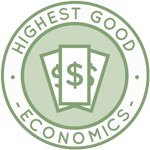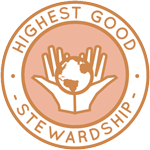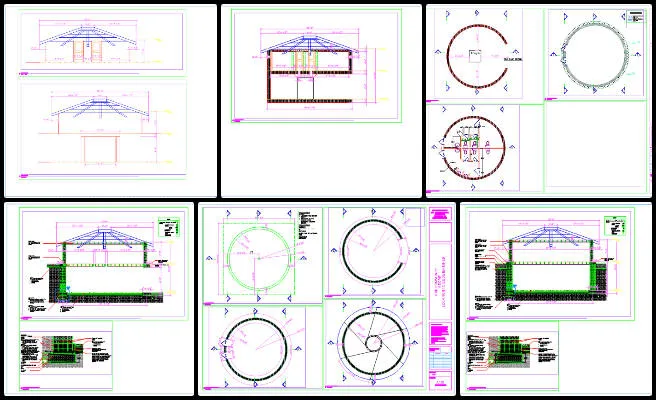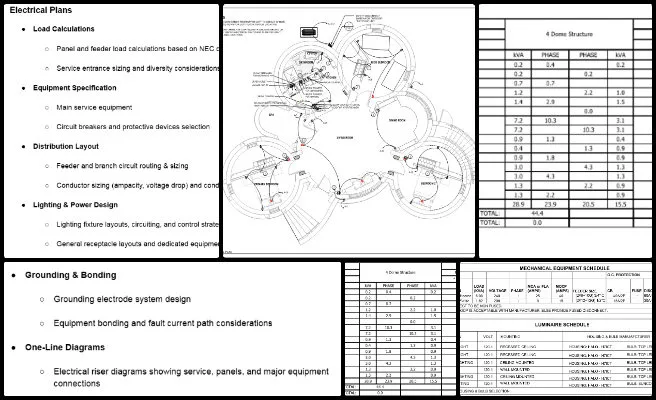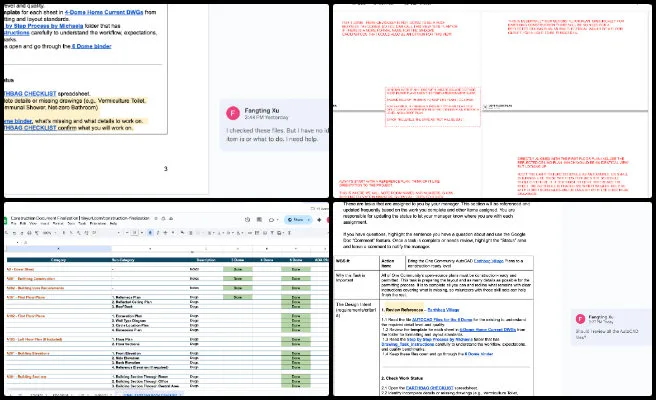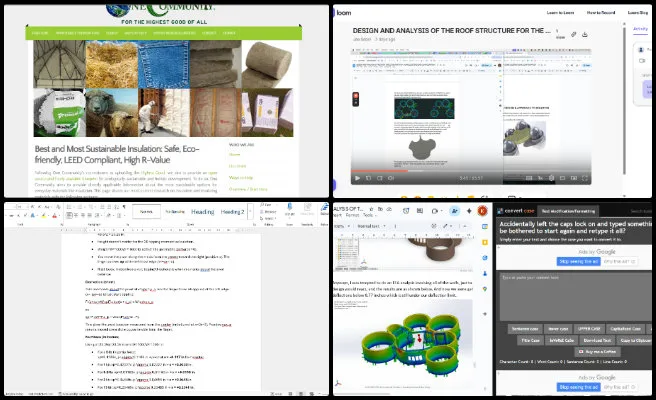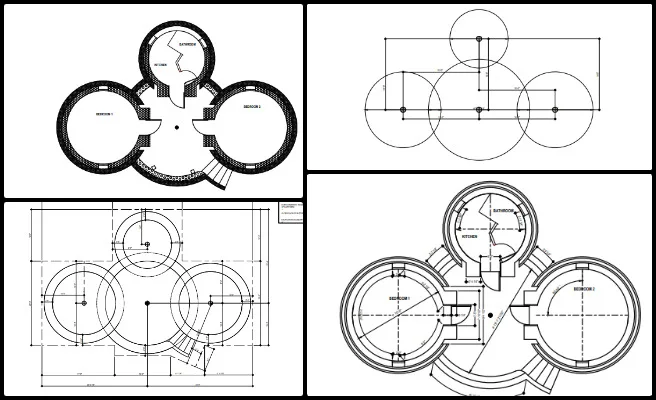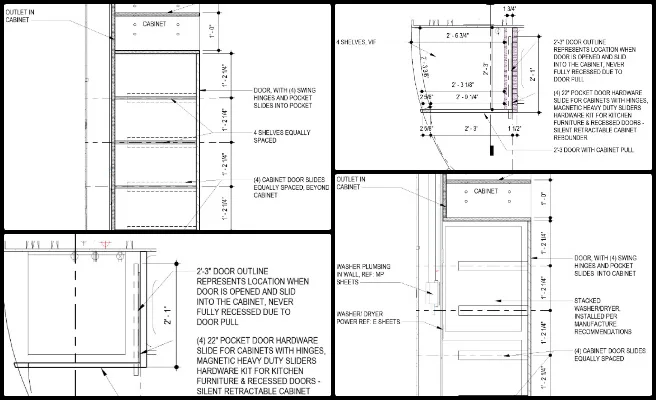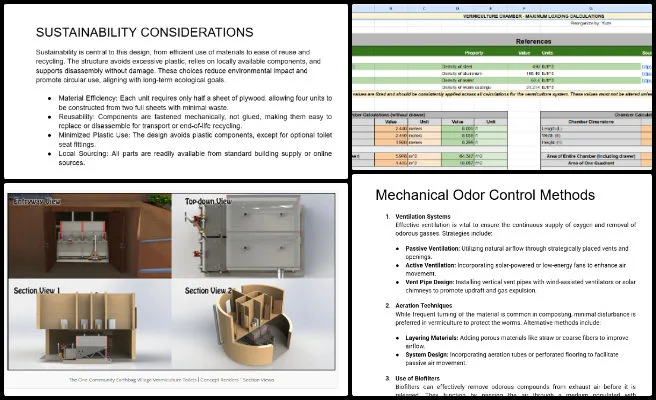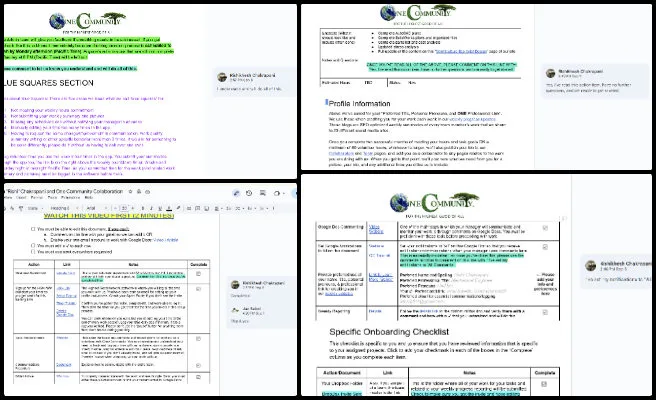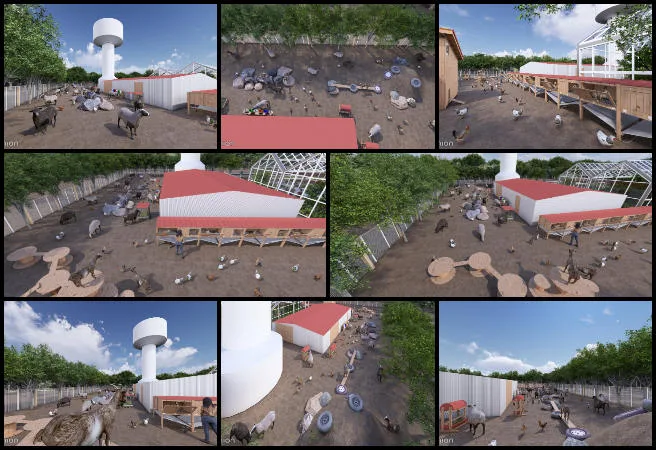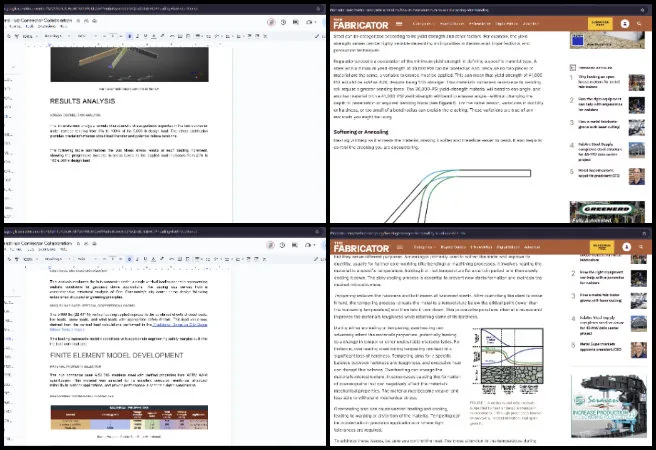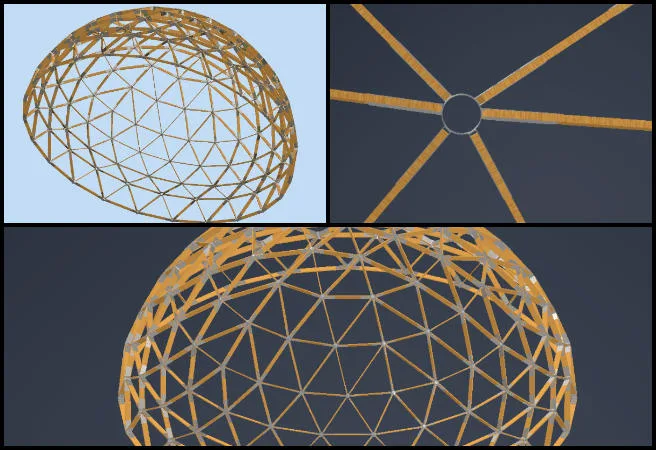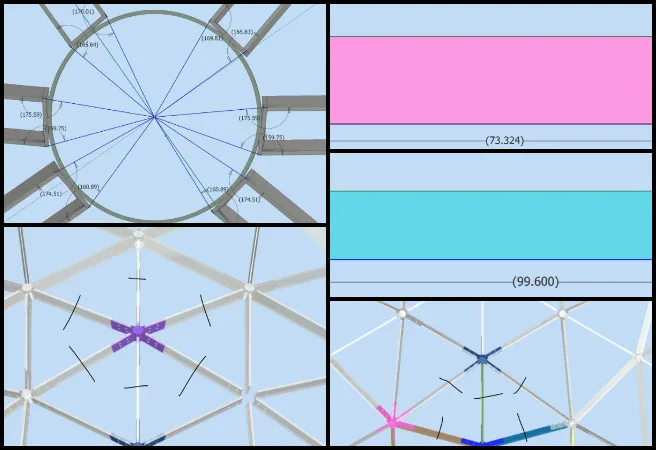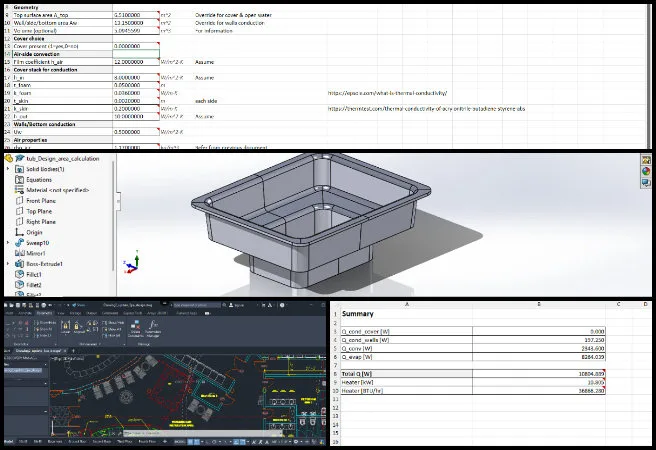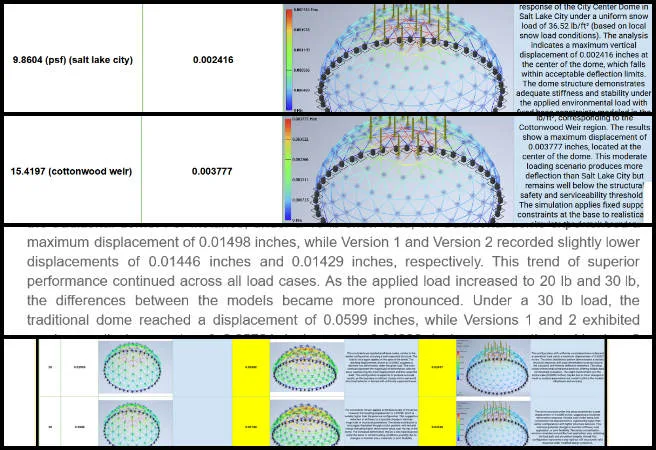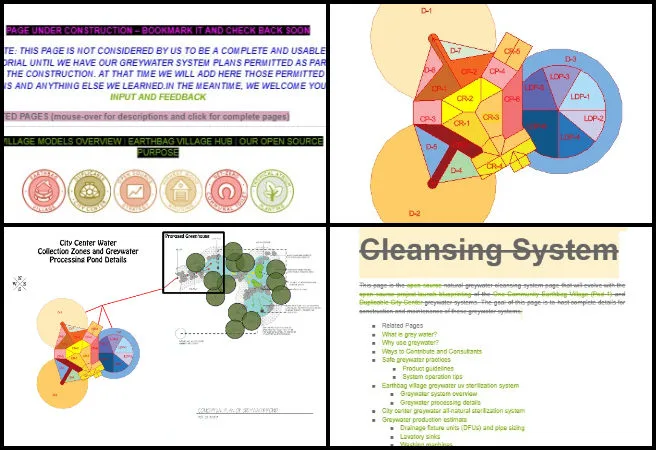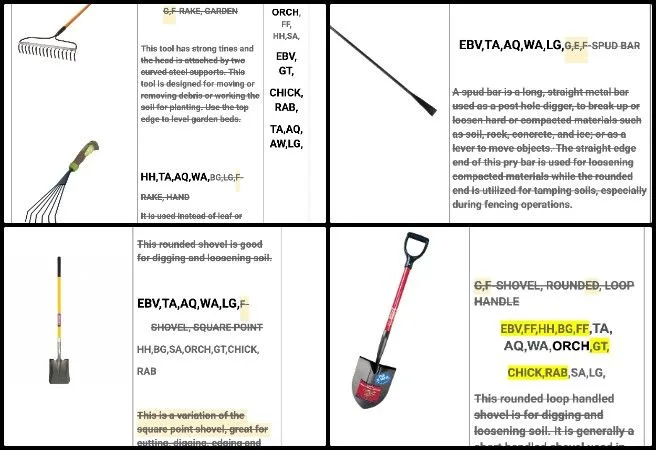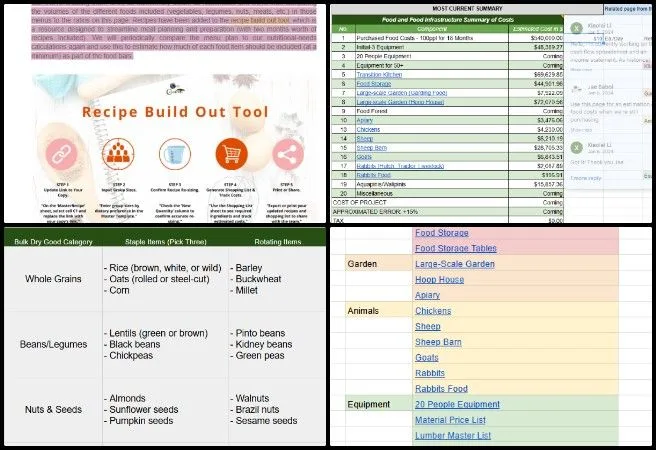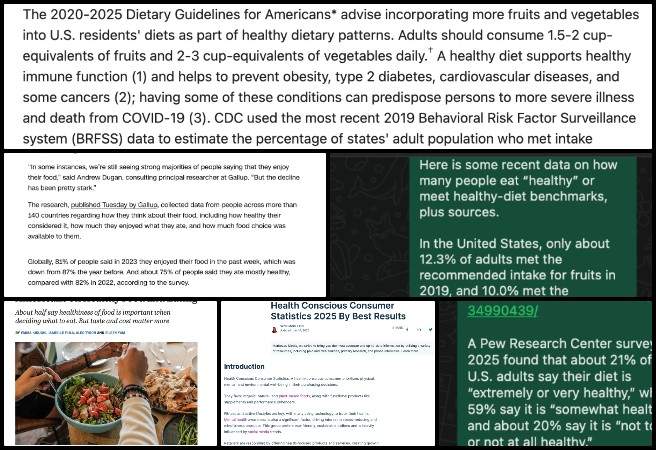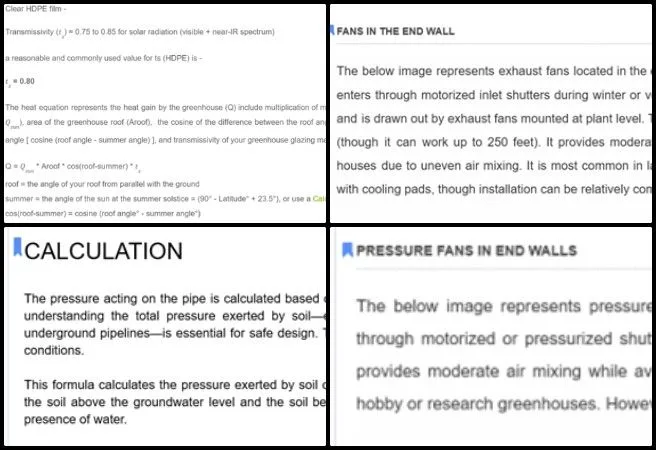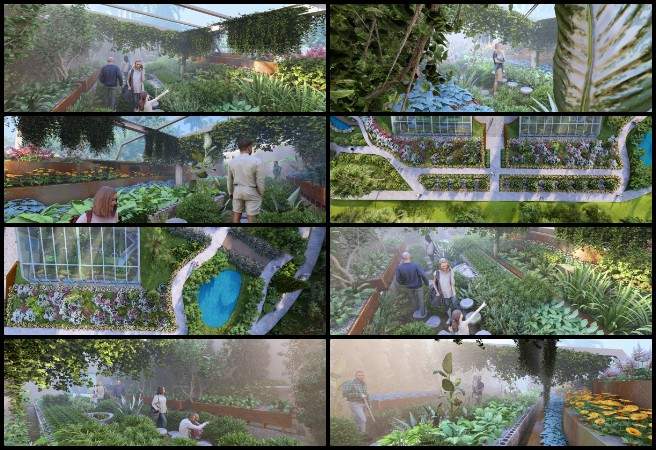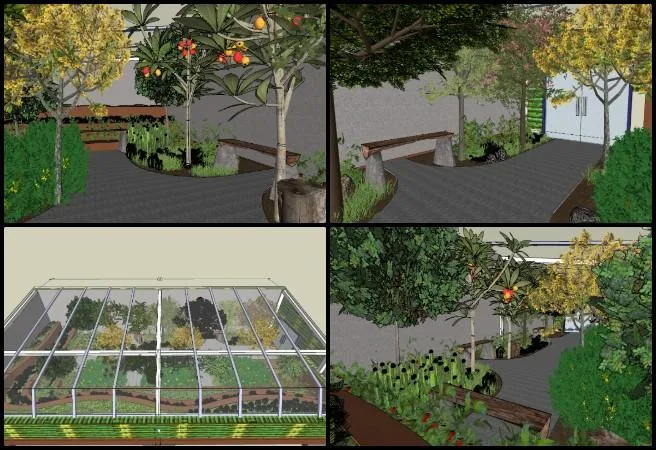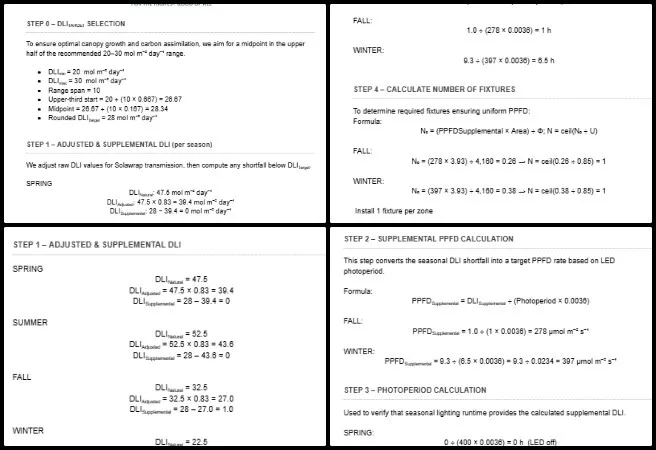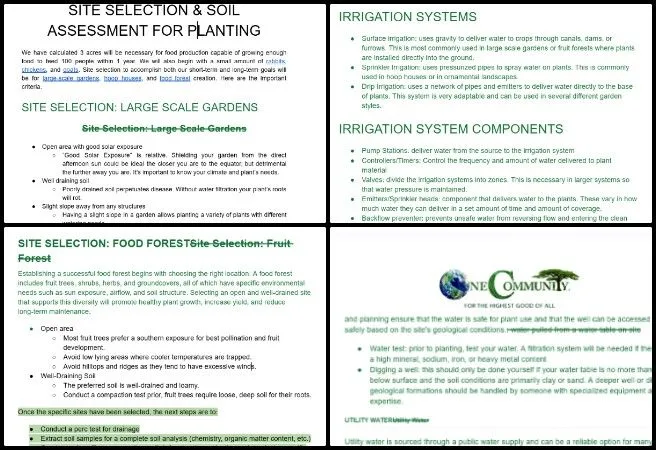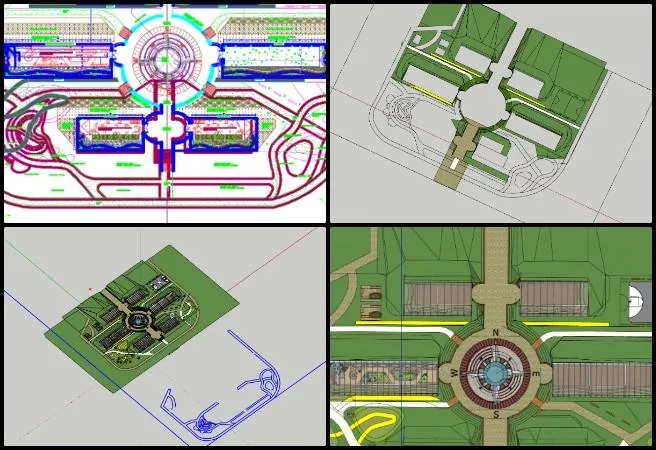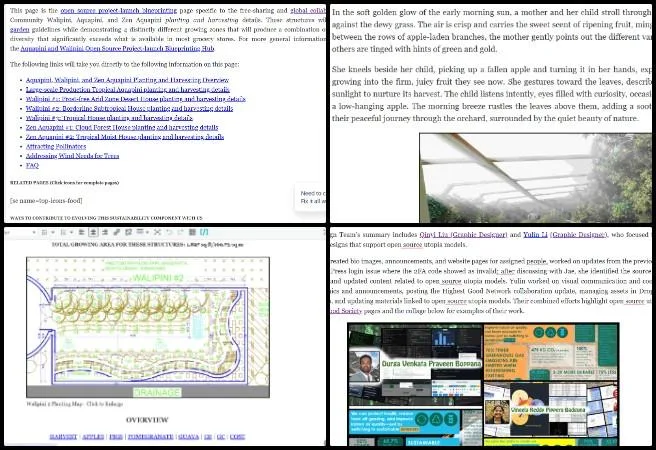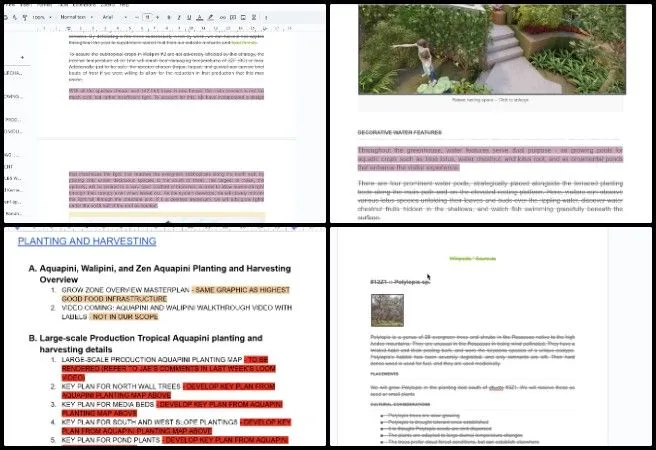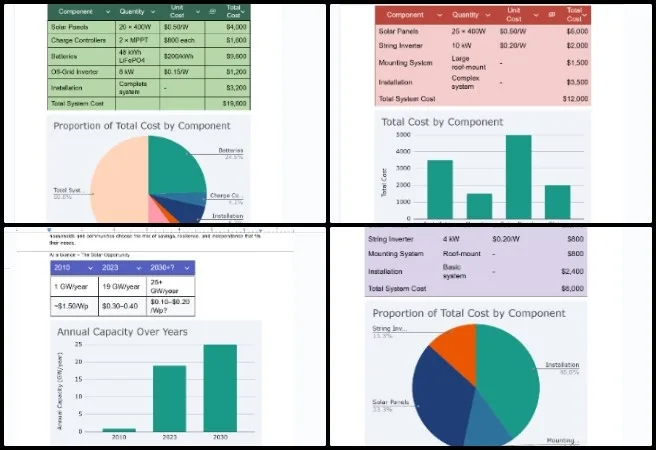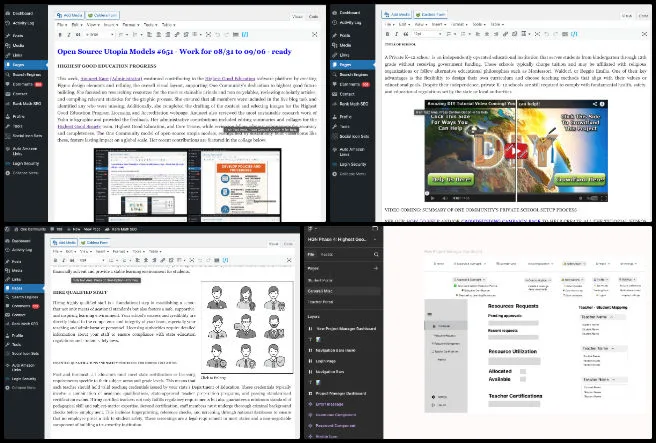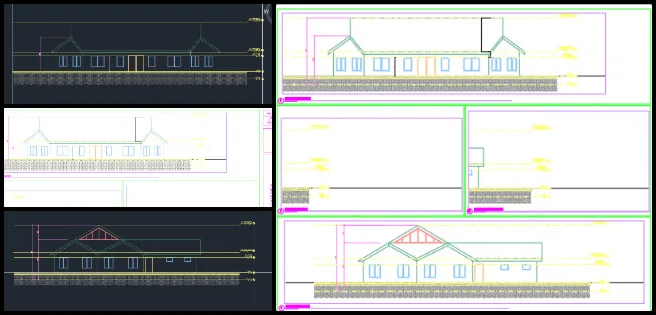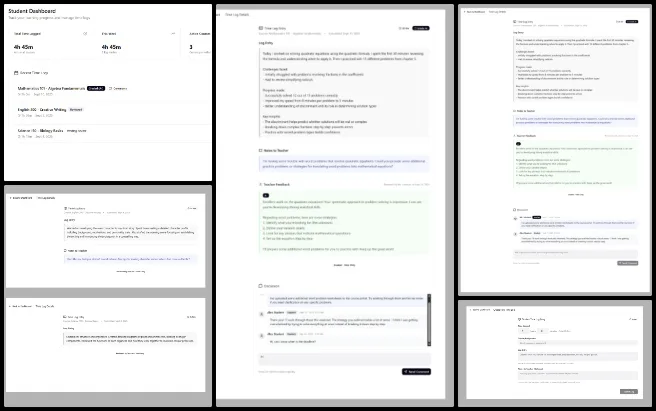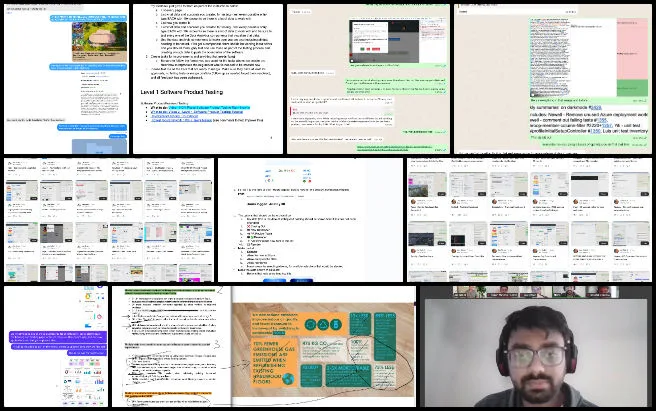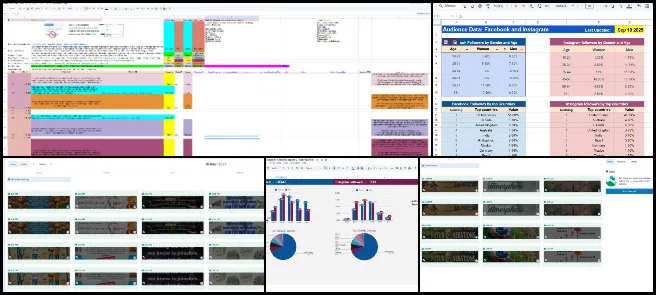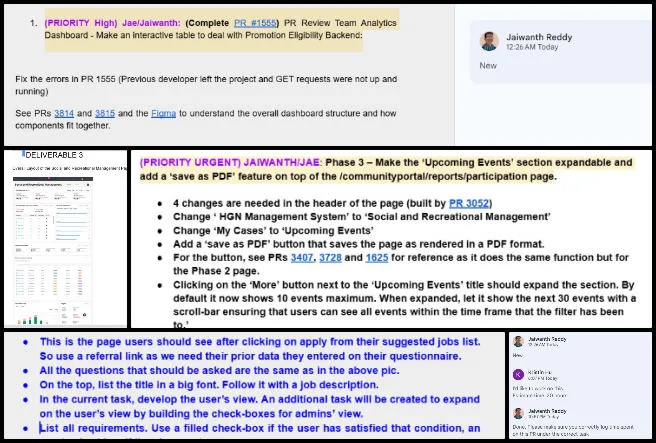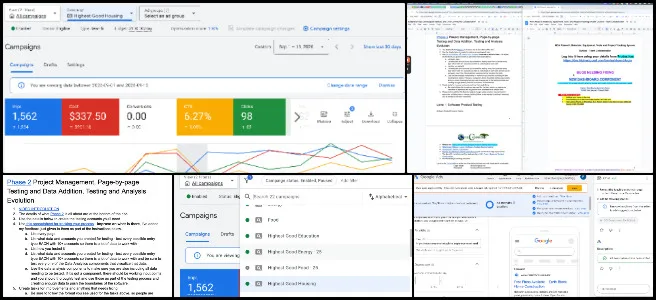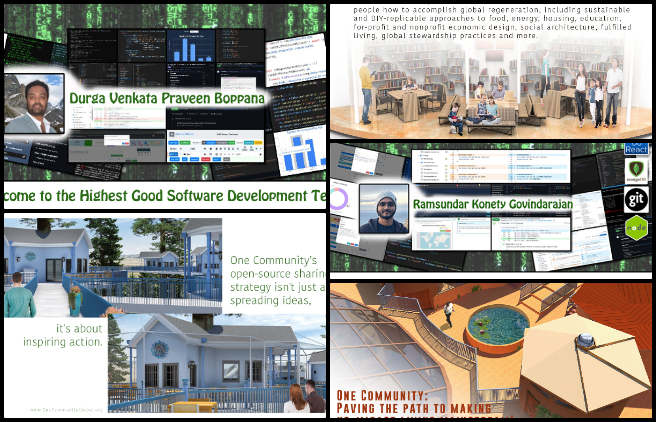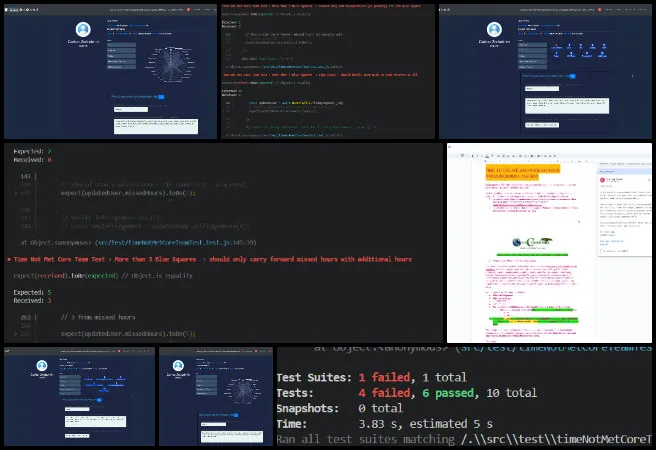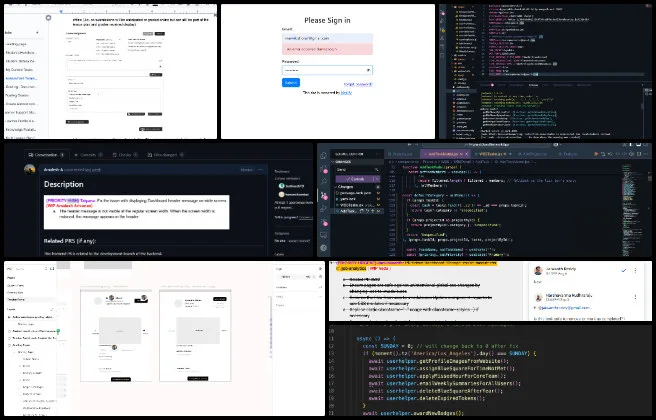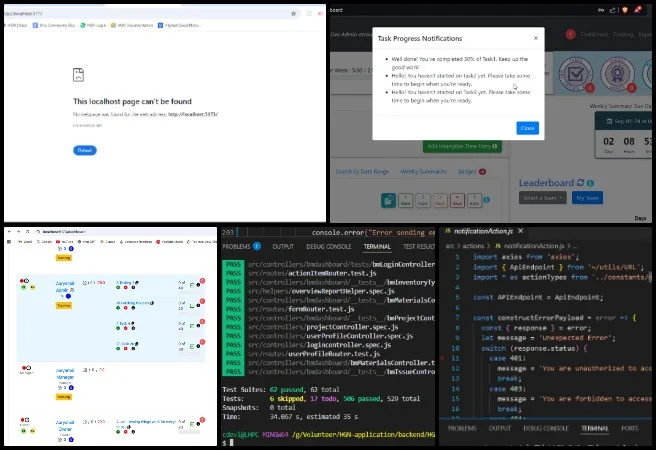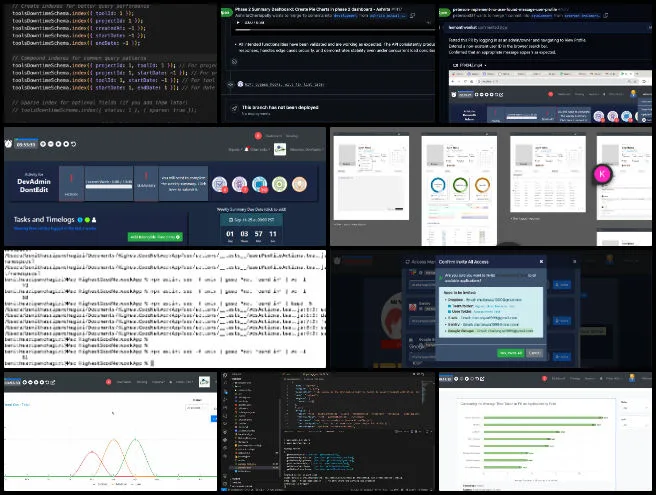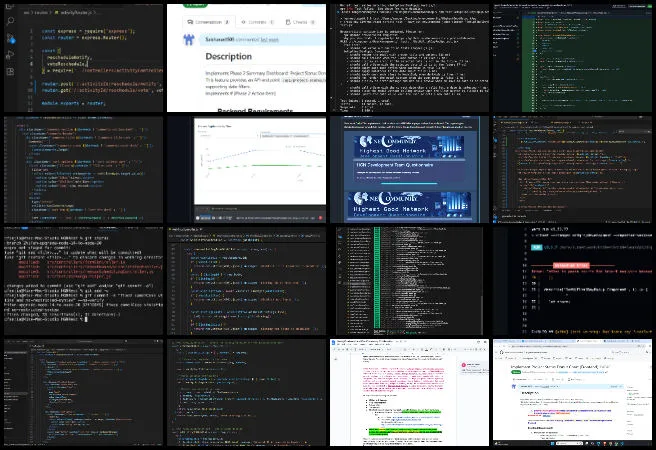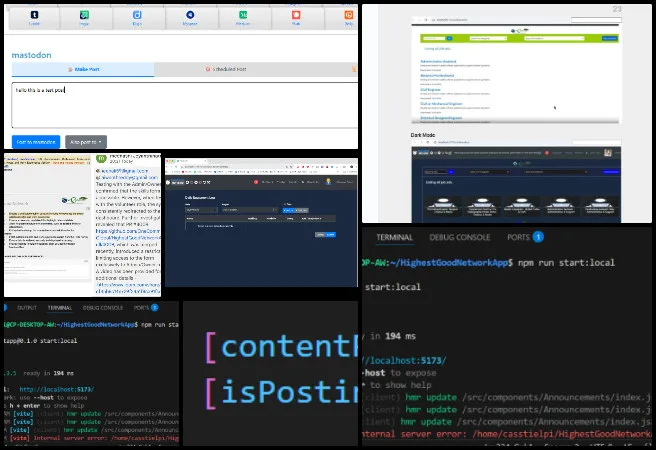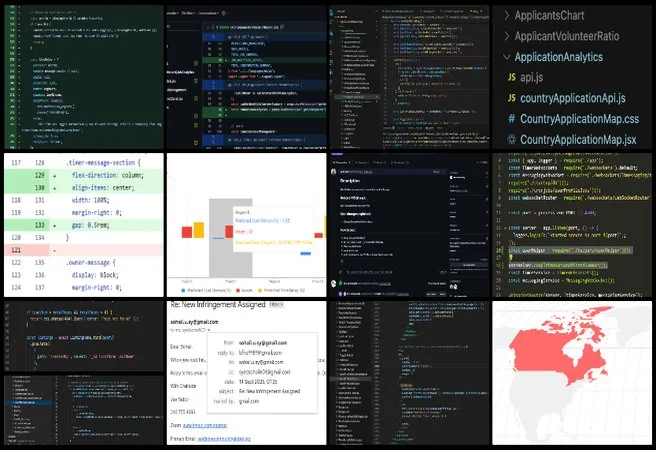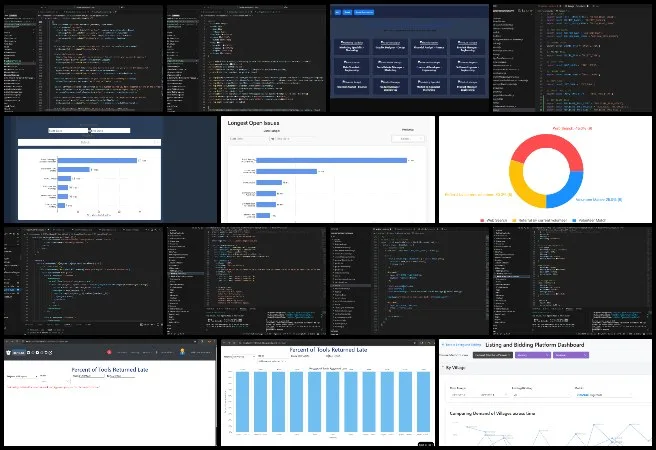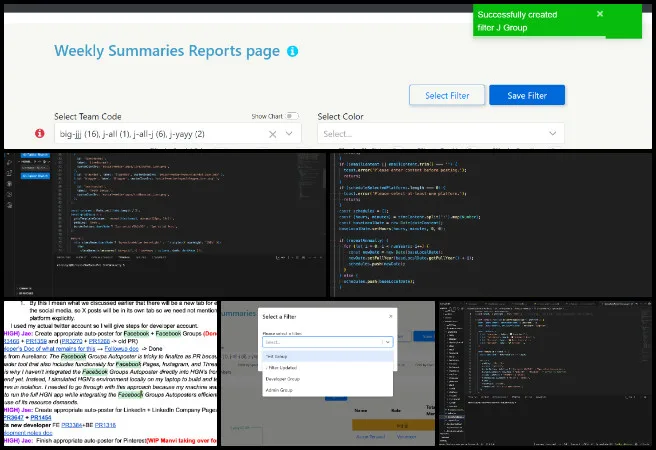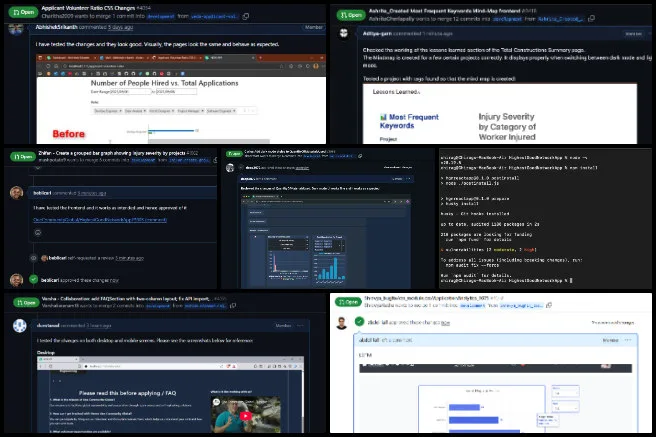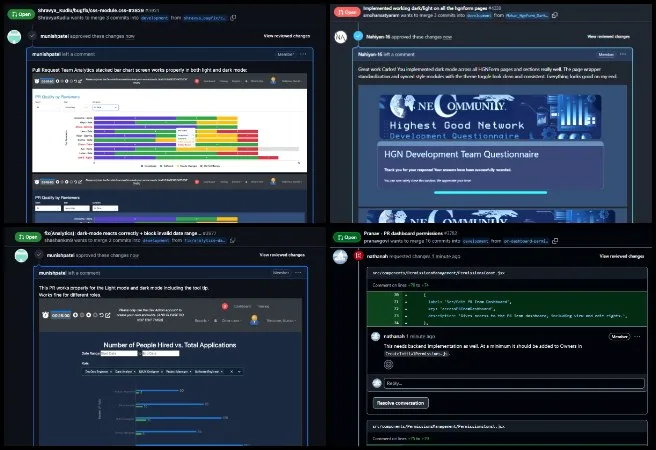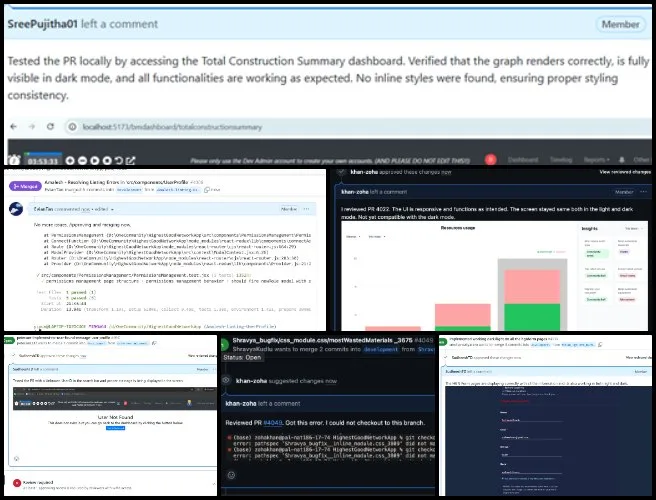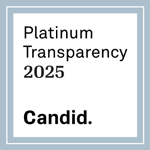Global-Sustainability Systems Design – One Community Weekly Progress Update #652
At One Community, we are developing global-sustainability systems design to integrate sustainable approaches to food, energy, housing, education, economics, social architecture, fulfilled living, and global stewardship practices into a comprehensive model for a better future. Created by an all-volunteer team and shared as open source and free-shared resources, this work is intended to be self-replicating, supporting a global collaboration of teacher/demonstration hubs. By open sourcing and free sharing the complete process, we are evolving sustainability, regenerating our planet, and creating a world that works for everyone—always for The Highest Good of All.
- Here’s our project overview
- Here’s our world-change methodology
- Here’s how this becomes self-replicating
- Here’s how we are open source and free-sharing all the do-it-yourself designs
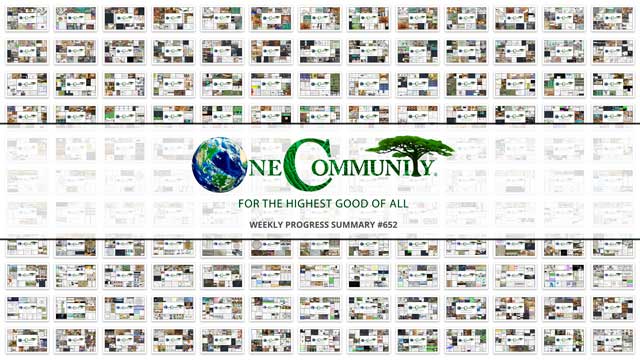
OUR MAIN OPEN SOURCE HUBS
Click on each icon to be taken to the corresponding Highest Good hub page.
One Community’s physical location will forward this movement as the first of many self-replicating teacher/demonstration communities, villages, and cities to be built around the world. This is the September 15, 2025 edition (#652) of our weekly progress update detailing our team’s development and accomplishments:
Global-Sustainability Systems Design
One Community Progress Update #652
DONATE | COLLABORATE | HELP WITH LARGE-SCALE FUNDING
CLICK HERE IF YOU’D LIKE TO RECEIVE AN EMAIL EACH WEEK WHEN WE RELEASE A NEW UPDATE
YOU CAN ALSO JOIN US THROUGH SOCIAL MEDIA
ONE COMMUNITY WEEKLY UPDATE DETAILS
HIGHEST GOOD HOUSING PROGRESS
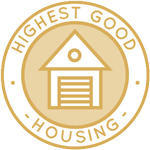 One Community is developing global-sustainability systems design through Highest Good housing that is artistic and beautiful, more affordable, more space efficient, lasts longer, DIY buildable, and constructed with healthy and sustainable materials:
One Community is developing global-sustainability systems design through Highest Good housing that is artistic and beautiful, more affordable, more space efficient, lasts longer, DIY buildable, and constructed with healthy and sustainable materials:
- Learn about: Our Upcoming Crowdfunding Campaign
- Learn about the different village models: 7 Sustainable Village Models
- Visit the open source portals for the first two: Earthbag Village OS Hub | Straw Bale Village OS Hub
This week, Baraka Minja (Civil and Environmental Engineer Pr. Eng.) continued working on the Vermiculture Toilet and communal shower CAD drawings. He added layouts to show wall types and edited the sections to reflect the current vermiculture design. He also continued developing the communal shower layouts, sections, and elevations by incorporating additional details in alignment with earthbag construction standards, ensuring consistency across the design documentation. As the first of seven planned villages, the Earthbag Village provides the initial housing within One Community’s open source designs for global-sustainability systems design. See the work in the collage below.
Derrell Brown (Plumbing Designer) continued working on the Earthbag Village 4-dome home details. He advanced work on the final MEP report by gathering electrical reference information on design and calculation breakdowns. He advanced work on the final MEP report by gathering electrical reference information and calculation breakdowns. He reviewed the latest electrical plans to update the scope of work section, aligning it with current design requirements. Derrell also developed step-by-step processes within the electrical scope to identify procedures for electrical design, with a particular focus on schedules and equipment. One Community’s open source designs for global-sustainability systems design begins with the Earthbag Village, the first of seven planned villages providing housing. See below for some of the pictures related to this work.
Fangting Xu (Interior Design Intern) started orientation, accepted all required software invitations, and familiarized herself with the project workflow by reviewing the drawing task instruction files. She also gained an understanding of the 6-dome and 3-dome files, exploring their structure and purpose within the project. In addition, Fangting learned about the “blue squares” section, including how these elements are defined and the process the team uses to obtain them. One Community’s open source framework for global-sustainability systems design begins with the Earthbag Village, the first of seven planned villages providing housing. See below for some of the pictures related to this work.
Karthik Pillai (Mechanical Engineer) continued work on the Earthbag Village 4-dome cluster project. For the roof design, after submitting an initial report outlining the current developments of the roof structure, he received feedback from the core team and began making revisions based on the comments provided. In parallel, work continued on the Vermiculture Toilet design, where a significant portion of the week was spent bringing new members up to speed on the project scope and progress. Alongside this, he worked on refining the design by making adjustments to the center pivoting point of the mechanism and carrying out related calculations to support the modification. As the first of seven planned villages, the Earthbag Village provides the initial housing within One Community’s open source designs for global-sustainability systems design. See the work in the collage below.
Ketsia Kayembe (Civil Engineer) continued working on the Earthbag Village 3-Dome structure, focusing on the excavation plans and Earthbag plans A102. She had a meeting with Dashaarna to review progress and address questions related to the drawings. Ketsia received feedback during the meeting and began making edits based on the comments provided. She also started working on the building sections and the structural column plans, using the four-dome drawings as a reference for the column locations. One Community’s open source framework for global-sustainability systems design begins with the Earthbag Village, the first of seven planned villages providing housing. See below for some of the pictures related to this work.
Michaela Silva (Architect) continued working on details in the construction documents of the Earthbag Village. She worked on the kitchen by creating a plan and section detail for an option that includes a stacked washer and dryer. She also created a separate plan and section detail showing an alternative layout with a pantry cabinet in place of the washer and dryer. The Earthbag Village is the first of seven villages to be constructed as part of One Community’s open source framework for global-sustainability systems design. See her work in the collage below.
Rahul Kulkarni (Mechanical Engineer) continued work on the Vermiculture Toilet. He reviewed the floor plans and overall design of the Earthbag Village to gain a better understanding of the requirements for the channel design. The report was reviewed with particular focus on the emptying chamber to check its alignment with the channel design needs. A prototype design was prepared for discussion with the team. Following discussions, the channel design process was formalized, and work began on finalizing the drawer modifications. The Earthbag Village, the first of seven planned villages, serves as the initial housing component within One Community’s open source framework for global-sustainability systems design. See below for some of the pictures related to this work.
Rishi Chakrapani (Mechanical Engineer) joined the team and completed the onboarding process by reviewing all documents provided by the core team and going through the associated reference materials. Each section of the provided information was examined to ensure understanding of the requirements and expectations. As part of the process, comments in the Google Doc were reviewed and acknowledged. The assigned action items were clearly understood and noted. The Earthbag Village, the first of seven planned villages, serves as the initial housing component within One Community’s open source framework for global-sustainability systems design. See below for some of the pictures related to this work.
DUPLICABLE CITY CENTER PROGRESS
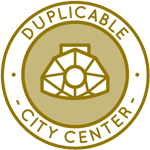 One Community is developing global-sustainability systems design through a Duplicable and Sustainable City Center that is LEED Platinum certified/Sustainable, can feed 200 people at a time, provide laundry for over 300 people, is beautiful, spacious, and saves resources, money, and space:
One Community is developing global-sustainability systems design through a Duplicable and Sustainable City Center that is LEED Platinum certified/Sustainable, can feed 200 people at a time, provide laundry for over 300 people, is beautiful, spacious, and saves resources, money, and space:
- Learn about this building and it’s function: Duplicable City Center Open Source Hub
This week, Anjana (Architectural Designer) continued working on the Duplicable City Center animal section, completing renders and walk-around videos while addressing feedback from previous reviews. She made corrections to the walking tour and real-time renders to align with requested adjustments, ensuring that all updates were implemented in the scenes. The updated assets were reviewed to confirm that the changes were applied accurately and to ensure the workflow maintained consistency with project standards. All modifications to the visual elements, camera paths, and scene compositions were finalized according to the specified requirements. This open-source Duplicable City Center project is developing global-sustainability systems design. For more details, refer to the image below.
Ariana Virginia Gutierrez Doria Medina (Industrial Designer) continued the analysis and cost estimation of the windows for the Duplicable City Center. She reviewed the details of the assembly and optimized the positioning of the pieces to minimize cuts and reduce wood waste. Additionally, costs were reviewed to determine how this optimization reduces both the labor hours for window construction and the overall material use. Explore One Community’s open-source Duplicable City Center for developing global-sustainability systems design, which empowers people to learn. Browse the visuals below.
Ayushman Dutta (Mechanical Engineer) continued working on reviewing pipe materials for the Duplicable City Center hub connector design. He worked on the report formatting of the FEA analysis and also repeated the FEA analysis for the holes to address previous issues. Ayushman made corrections to the FEA analysis, finished the formatting, and added links to the source files in Dropbox for better accessibility. He worked on the manufacturing process document, completing research about different processes required for the hub connector. Ayushman also researched the bending of the spoke plate with aluminum material, focusing on heating requirements and surface considerations to understand the manufacturing constraints and requirements for the project. This open-source Duplicable City Center project is developing global-sustainability systems design. For more specifics, view the image below.
Koushik Chandra Katta (Mechanical Engineer) joined the team and began by working on the Duplicable City Center Inventor model, focusing on the beam elements to improve accuracy and alignment. He created new beams where needed and adjusted existing ones to meet the project’s design specifications, trimming excess sections to ensure clean intersections and proper load distribution throughout the structure. Explore One Community’s open-source Duplicable City Center for developing global-sustainability systems design, which empowers people to learn. Browse the visuals below.
Nikhil Bharadwaj (Mechanical Engineer) continued working on creating the spoke designs for the Duplicable City Center He drafted the 2D flattened drawings for each spoke to aid fabrication and assembly and added these drawings to the assembly spreadsheet. He integrated the row 3 hub connector into the complete dome assembly, cut the beams to achieve the required clearances and fit, and obtained the beam cut angles, adding color-coded screenshots to the spreadsheet. Nikhil connected with Koushik to discuss the next steps for completing the dome assembly and planned next steps with Nupur to finalize the row 3 assembly spreadsheet, manage the handoff, understand the procedure for drafting the assembly document, and obtain all related files. One Community’s Duplicable City Center is an example of developing global-sustainability systems design. Here are a few pictures that showcase this work.
Sandesh Kumawat (Mechanical Engineer) continued working on the City Center Natural Pool and Eco-spa Designs. He reviewed the spa layout in AutoCAD to verify clearances around the pool edges and adjacent features, adjusted the envelope where needed, and conducted a circle-packing analysis to estimate the number of occupants that can be accommodated within the water surface while maintaining spacing. He documented key distances (edge offsets, aisle widths, and equipment clearances) and noted any locations that approached minimums. Sandesh then updated the SolidWorks model to match the latest plan geometry, rebuilding mates and sketches so the 3D assembly reflects the revised footprint and wall profiles. In parallel, he refined the thermal Excel workbook by updating inputs and formulas for conduction through the cover stack, surface convection, and evaporation, and summarized the losses into heater power and energy use so the model can compare operating scenarios. Discover One Community’s open source Duplicable City Center for developing global-sustainability systems design. The following visuals illustrate highlights from this effort.
Srujan Pandya (Mechanical Engineer) continued helping with the Duplicable City Center FEA analysis. He focused on completing the revised snow load analysis for Version 1, carefully validating the results and updating the worksheet with accurate calculations. He integrated these outcomes into the main report, ensuring proper formatting, inclusion of images, and referenced sources as comments. After finalizing the snow load section, Srujan began preparing for the earthquake analysis and scheduled a meeting with Dipak for Monday. The Duplicable City Center demonstrates developing global-sustainability systems design and open source solutions that can guide people. The images below illustrate aspects of this work.
Vineela Reddy Pippera Badguna (Mechanical Engineer) continued conducting in-depth research on greywater reuse systems for the Duplicable City Center. She reviewed and verified the greywater and rainwater catchment calculations in detail. She updated the report by adding an overview section and related page icons based on feedback. Vineela also updated the pictures by replacing the old images with new ones, and added cross-references to the Duplicable City Center and Greywater pages, plus placeholders for future visuals. In addition, she included source links for all images, updated the additional design details section, and reviewed the greywater website content. This open source open source Duplicable City Center project is developing global-sustainability systems design. For more details, refer to the image below.
HIGHEST GOOD FOOD PROGRESS
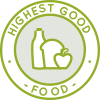 One Community is developing global-sustainability systems design through Highest Good food that is more diverse, more nutritious, locally grown and sustainable, and part of our open source botanical garden model to support and share bio-diversity:
One Community is developing global-sustainability systems design through Highest Good food that is more diverse, more nutritious, locally grown and sustainable, and part of our open source botanical garden model to support and share bio-diversity:
- Learn about the structures: Hoop House Hub | Aquapini & Walipini Open Source Hub
- See what we’ll be growing: Gardens & Hoop Houses | Large-scale Structures | Food Forest | TA
This week, the core team continued working on the Master Tools, Equipment, and Materials and Supplies List for the Large Garden. This involved individual reviews of the Master Document entries to address inconsistent acronym punctuation and the absence of specific items under the LG designations. The list is anticipated to be completed next week, after which the focus will shift to the Botanical Garden. The Highest Good Food initiative is a key component of One Community’s open source plans, focused on global-sustainability systems design, and exemplifies the organization’s commitment through innovative design and implementation. Below are some images showcasing this work.
The core team also continued providing feedback on the Highest Good Food documents, including combining multiple food spreadsheets into one, creating a new data table, and adding a hyperlinked table of contents. In addition, the team reviewed and made changes to the Transition Kitchen pages, Food Procurement and Storage, Food Self-Sufficiency Plan, Sustainable Food Nutrition Calculations, Recipe Build-Out Tool, Food Bars, and Recipe pages. All Highest Good Food reports are expected to be ready for publication by the end of next week. The Highest Good Food initiative plays a leading role in One Community’s open source platform by promoting sustainable and participatory development focused on global-sustainability systems design. Below are images related to this project.
Chelsea Mariah Stellmach (Project Manager) continued her work on the Transition Food Self-sufficiency Plan menus and customization spreadsheets. Chelsea watched the Loom videos Jae provided and made changes throughout the reports to fine-tune them. The core team requested additional help from Chelsea with the Frequently Asked Questions (FAQ) section so it would connect more closely with the other pages and tools, and the team also asked her to gather information on healthy eating practices. As an essential aspect of One Community’s open source goals, the Highest Good Food initiative supports global-sustainability systems design as a foundation for sustainable living. Below are some images showcasing this work.
Dirgh Patel (Mechanical Engineer) continued assisting with the Climate Battery design updates. He edited the final report by adding an introduction with images of ventilation types, describing how the three types differ and outlining their characteristics. He also edited the stress and strain simulation section to include extra details for clarity and understanding. Dirgh then updated the assumptions section of the stress and strain simulation, expanding the explanations in the results section to provide clearer justification and ease of understanding, while moving the ventilation information to a separate section. He worked on the Excel file by updating images, revising the equation explanation in the heating design, and adding explanations of symbols for the thermal convection coefficient and pressure units. Dirgh added explanations to the thermal simulation assumptions and results to improve clarity. One Community’s open-source mission is powerfully reflected in the Highest Good Food initiative, which is focused on global-sustainability systems design for global benefit. The following visuals illustrate highlights from this effort.
Faeq Abu Alya (Architectural Engineer) continued developing house designs for the Earthbag Village 4-dome cluster project. He designed houses in both the Southwest and Southeast areas, focusing on updating materials used in the models to ensure consistency and accuracy, while also introducing new features that align with project requirements. In addition, the visual presentation of the houses was enhanced for clarity and overall appearance, ensuring the models meet the intended design standards. The Earthbag Village is the first of seven planned villages to be constructed as part of One Community’s open-source model for global-sustainability systems design, and it is closely tied to the Highest Good Food initiative. Below are some pictures related to this work.
Gayatri Pandkar (Architect) continued contributing to the Highest Good Food initiative. She refined the plantation tree layout to better align with the original plan and explored various seating options appropriate for the project site. She also introduced plantings at ground level and reviewed their integration into the overall layout to ensure consistency with the design framework and support the intended functionality of the space. She also began working on the rendering file for the Walipini structure. The Highest Good Food initiative plays a leading role in One Community’s open source platform by promoting sustainable and participatory development focused on global-sustainability systems design. Below are visuals highlighting this work.
Jay Nair (BIM Designer) continued working on Aquapini and Walipini Planting and Harvesting. documents. He standardized the document format to align with the webpage layout and presentation. At the same time, he began developing a concept for the user interface of a software tool for performing lighting energy calculations in greenhouses, focusing on defining the functional requirements and layout structure. The Highest Good Food initiative plays a leading role in One Community’s open source platform, promoting global-sustainability systems design through sustainable and participatory development. See below for pictures related to this work.
Keerthi Reddy Gavinolla (Software Developer) continued working on the Highest Good Food page. She reviewed the Code Crafters team’s work and updated their blog. She also continued working on the Soil Amendment and Initial Off-Grid Site Preparation page, making updates based on Jae’s feedback. Keerthi adjusted the formatting, added required content, including paragraphs after each heading and before bullet points, and completed her admin work for the week. Built on One Community’s open source foundation, the Highest Good Food initiative is dedicated to global-sustainability systems design, empowering communities through self-sustaining systems. View examples of her work in the pictures below.
Nitin Parate (Architect) continued contributing to the Highest Good Food initiative. His work focused on multiple updates and refinements to the site drawings and models. The updated Southwest site plan was reviewed for integration with the remaining parts of the site to maintain consistency and accuracy across drawings. Initial updates did not align well with the existing layout, requiring further adjustments and coordination. The master plan was then revised in discussion with Jae to resolve alignment issues and incorporate the necessary changes. Parallel to this, the SketchUp file was updated based on the revised AutoCAD base to prepare the Axonometric View, with efforts directed toward ensuring correct scale, proportions, and consistency with the overall layout. Focus then shifted to developing the Sun Study Axonometric View, highlighting sunlight movement while maintaining scale and proportion accuracy to align with project requirements and presentation standards. The Highest Good Food initiative plays a leading role in One Community’s open source platform, promoting and supporting the global-sustainability systems design through sustainable and participatory development. Below are some images showcasing this work.
Pallavi Deshmukh (Software Engineer) continued working on the Aquapini and Walipini Planting and Harvesting pages. She created new content for blog 651 and completed and submitted information for eight interviews, scheduling more for next week. She worked with teammates by reviewing their suggestions and incorporating feedback to produce a clear and consistent final version. She applied Jae’s feedback and added Zenapini #2 content from Silin to the website, then moved on to Walipini #2, incorporating Junyi Shi’s work with updated text, links, and images for the webpage. In alignment with One Community’s open source objectives, the Highest Good Food project integrates the concept of global-sustainability systems design into a larger vision of regenerative living. Her contributions are highlighted in the collage below.
Shivangi Varma (Architectural Designer and Planner) continued contributing to the Highest Good Food initiative. She made edits to the overview of the Planting and Harvesting content and the developed Zenapini 2 details. She also began creating content for the other structures, including text and determining the placement of the necessary graphics. The Highest Good Food initiative plays a leading role in One Community’s open source platform by promoting sustainable and participatory development focused on global-sustainability systems design. Below are visuals highlighting this work.
HIGHEST GOOD ENERGY PROGRESS
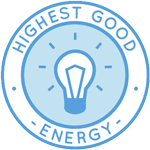 One Community is developing global-sustainability systems design through Highest Good energy that is more sustainable, resilient, supports self-sufficiency and includes solar, wind, hydro and more:
One Community is developing global-sustainability systems design through Highest Good energy that is more sustainable, resilient, supports self-sufficiency and includes solar, wind, hydro and more:
- Learn about the open source sustainable-energy foundations: Solar, Hydro, and Wind
- Explore our research into the most sustainable products and companies for saving water and energy: Insulation, Eco-laundry, Lightbulbs and Light Bulb Companies, Doors and Door Companies, Windows and Window Companies, Toilets, Faucets and Faucet Accessories, Urinals, and more.
This week, Shravan Murlidharan (Electrical Engineer) continued supporting the Highest Good Energy initiative. He focused on reorganizing and refining the One Community Solar webpage. The effort involved optimizing the presentation of tables and charts while ensuring that the information was arranged in a logical and accessible manner. Each day was dedicated to improving the structure so that data was displayed clearly, with particular attention to consistency across sections and alignment between visual elements and supporting content. This included adjustments to both layout and formatting so the webpage presented information in a streamlined, coherent way that enhanced usability and clarity for readers. One Community’s open source mission is powerfully reflected in the Highest Good Energy initiative, which supports global-sustainability systems design as a model for global benefit. Below are some of the images showcasing this work.
HIGHEST GOOD EDUCATION PROGRESS
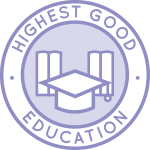 One Community is developing global-sustainability systems design through Highest Good education that is for all ages, applicable in any environment, adaptable to individual needs, far exceeds traditional education standards, and more fun for both the teachers and the students. This component of One Community is about 95% complete with only the Open Source School Licensing and Ultimate Classroom construction and assembly details remaining to be finished. We’ll report on the final two elements to be finished as we develop them. With over 8 years of work invested in the process, the sections below are all complete until we move onto the property and continue the development and open sourcing process with teachers and students – a development process that is built directly into the structure of the education program and everything else we’re creating too:
One Community is developing global-sustainability systems design through Highest Good education that is for all ages, applicable in any environment, adaptable to individual needs, far exceeds traditional education standards, and more fun for both the teachers and the students. This component of One Community is about 95% complete with only the Open Source School Licensing and Ultimate Classroom construction and assembly details remaining to be finished. We’ll report on the final two elements to be finished as we develop them. With over 8 years of work invested in the process, the sections below are all complete until we move onto the property and continue the development and open sourcing process with teachers and students – a development process that is built directly into the structure of the education program and everything else we’re creating too:
- Program Overview: Education Open Source Hub
- How the components work together in designing human orchestrated eco-abundance: How to use the Education for Life Program
- Lesson Plans for Life – Lesson Plans How-to
- Foundations of Outstanding Leaders, Teachers, and Communicators
- Curriculum for Life
- Teaching Strategies for Life
- Learning Tools and Toys for Life
- Evaluation and Evolution
This week, Anuneet Kaur (Administrator) continued contributing to the Highest Good Education software platform by creating Figma design elements and refining the overall visual layout, supporting One Community’s dedication to Highest Good Future Building. This work reflects One Community’s dedication to global-sustainability systems design. She updated the Project Manager Dashboard using Figma according to Harshitha’s feedback, incorporating design adjustments to improve usability and ensure consistency with project standards. She focused on researching resources for the most sustainable flooring, reviewing scholarly articles, and compiling relevant statistics for the graphic process. Anuneet ensured that all members were included in the live blog task and identified any who were missing. Additionally, she completed drafting the content and selecting images for the Highest Good Education Program Licensing and Accreditation webpage. Her administrative contributions included editing summaries and collages for the Highest Good Society team, Highest Good Education, and core team, while reviewing fellow admins’ submissions for accuracy and completeness. The One Community model of global-sustainability systems design, exemplified by sustainably built classrooms like these, fosters lasting impact on a global scale. Her recent contributions are featured in the collage below.
Dashaarna Srinivasa (Project Engineer) began developing the Highest Good Education platform, detailing deliverables. She worked on Blog #651 by creating detailed summaries for the volunteer contributions and designing visual collages to accompany them, ensuring they aligned with publication standards. She reviewed and provided feedback on the compiled work to maintain consistency and accuracy across all sections. Dashaarna also conducted a coordination meeting with Ketsia and Baraka to discuss their current progress, clarify deliverable expectations, and address any blockers. She maintained ongoing communication with Ananya and Fangting to track their tasks and ensure they remained aligned with the overall timeline. Lastly, she continued developing the Ultimate Classroom drawings in AutoCAD, focusing on drafting the building elevation to establish the foundational layout for further detailing. The One Community model of global-sustainability systems design, exemplified by sustainably built classrooms like these, drives lasting impact on a global scale. Her recent contributions are featured in the collage below.
Harshitha Rayapati (Program Manager) continued advancing the Highest Good Education platform by detailing deliverables, developing Figma designs, and expanding the visual layout of the student dashboard. She reviewed Anuneet’s Figma design for the Project Manager Profile and detailed the action items into PRs for Phase 4 ensuring consistency across all software components. Srishti was onboarded, and her Figma work on the Teacher Dashboard was reviewed, while Vivek was onboarded to the HGN Phase 4 backend tasks. Questions from Raahul regarding deliverables were clarified, and repositories and resources were identified to help the onboarded software engineers better understand the documentation and available materials. The One Community model of global-sustainability systems design, exemplified by sustainably built classrooms like these, advances meaningful global change. The collage below highlights her recent contributions.
Ravi Kumar Sripathi (Software Engineer) continued developing the Highest Good Education software platform by creating Figma designs and refining the Build Lesson Plan module, which enables students to transform their saved interests into weekly learning plans through guided steps. This work supports One Community’s mission of global-sustainability systems design. He worked on the student logging interface, which was designed with a timer-based system to record time spent on tasks in the lesson plan. The interface includes a text box for entering logs, a dropdown menu for selecting related courses or assignments or marking entries as general logs, and an optional notes section for sending questions or clarifications to the teacher. Rules were defined to allow editing until the teacher had reviewed the log, after which the log becomes view-only with teacher comments and grades displayed when applicable. Commenting features were added for interaction between student and teacher after grading, and the submission process was set up to return students to the dashboard after submitting logs. These updates strengthened both the functionality and user experience of the platform, enhancing the One Community model of global-sustainability systems design as a path to lasting global impact. Below are images related to his work.
HIGHEST GOOD SOCIETY PROGRESS
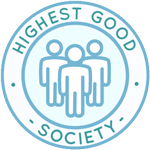 One Community is developing global-sustainability systems design through a Highest Good society approach to living that is founded on fulfilled living, the study of meeting human needs, Community, and making a difference in the world:
One Community is developing global-sustainability systems design through a Highest Good society approach to living that is founded on fulfilled living, the study of meeting human needs, Community, and making a difference in the world:
- Read the Highest Good society overview: Highest Good Society
- Learn about the model for fulfilled living and sharing: A Day in the Life
- Learn about the 4 economic models: RBE | For-profit | Non-profit | Entrepreneurship
- Learn about our open source community collaboration and management software: The Highest Good Network
This week, the core team completed over 66 hours managing volunteer work reviews, handling emails, overseeing social media accounts, supporting web development, identifying new bugs, integrating bug fixes for the Highest Good Network software, and interviewing and onboarding new volunteer team members. They also produced and integrated the video above, highlighting how global-sustainability systems design serves as the foundation of One Community’s broader mission. The following images showcase highlights of this work.
Govind Sajithkumar (Project Manager) continued focusing on analytics and content management for Meta’s Facebook and Instagram channels. He created and scheduled new posts for the Facebook and Instagram feeds and recorded all content details, data, and analytics in the Open Source spreadsheet. He also performed the weekly update of social media analytics by collecting and processing new audience data and refreshing the master spreadsheet with current audience demographics and engagement statistics. Additionally, Govind completed PR Review Team Management by modifying a WordPress site with the team’s weekly summary and collage, filling the PR Review Team Table, and updating the Highest Good Network PR spreadsheet. He submitted his admin feedback table, which further supports One Community’s mission of global-sustainability systems design. The images below highlight key aspects of his contributions.
Jaiwanth Reddy Adavalli (Project Manager) continued developing the Job Applicants page and key components of the Highest Good Network Phase 2 and Phase 4 dashboards, including the PR Team analytics section. He worked on the Social Architecture Software, Application Page, and PR Review Dashboard by creating action items for new components. He tracked updates in software team management documents to support task management. Jaiwanth also tested multiple pull requests in the Highest Good Network software. As a member of the pull request review team, he reviewed submissions from the volunteer team assigned to him. This work supports One Community’s commitment to global-sustainability systems design. The images below highlight his contributions.
Rajrajeshwari Gangadhar Sangolli (Data Analyst) continued working on Google Ads management and strategy evolution. She tracked key KPIs for running ads, monitored weekly performance, and applied Google recommendations to improve results, including removing redundant keywords, adding select broad match versions of existing keywords, and updating ad headlines and descriptions. She reviewed over 25 ads in housing and society campaigns, created twelve new ad groups based on the site map, improved responsive search ads, and paused underperforming campaigns while noting stronger performance in newer philosophy and housing campaigns compared to older ones. Additional tasks included reviewing a new admin’s work with comments, following Jae’s instructions for the product testing group, reviewing videos and raising related questions, and starting a process documentation file for the ads team. Rajrajeshwari also made progress on Google certifications. This project supports One Community’s commitment to global-sustainability systems design. The images below highlight key aspects of her work.
ADMINISTRATION TEAM
The Administration Team’s summary, which covers their work on the Highest Good Network, was managed by Prudhvi Marpina (Data Analyst) and includes Ashutosh Mishra (Software Engineer), Divanshu Bakshi (Team Admin), Georgina George (Business Intelligence Analyst), Indra Anuraag Gade (Software Engineer and Team Administrator), Keerthana Chitturi (System Administrator), Neeharika Kamireddy (Data Analyst), Olimpia Borgohain (Data Analyst and Team Administrator), Rachna Malav (Data Analyst), Rajeshwari Bhirud (Administrator), Rishi Sundara (Quality Control Engineer and Team Administrator), Rishitha Adepu (Administrator), Sai Suraj Matta Veera Venkata (Business Data Analyst), Samhitha Are (Administrator), Sudarshan Raju Chintalapati Venkata (Data Analyst) and Yagna Reddy Badvel (Data Analyst and Team Administrator). The Administration Team supports the Highest Good Network, a tool designed to manage and objectively measure progress while building open-source solutions for global sustainability. Through their focus on administrative support, documentation, testing, training, recruiting, analytics, and content management, the team directly contributes to creating global-sustainability systems design and One Community’s mission of building a replicable model for a sustainable world.
This week, Ashutosh completed partial integration of the chatbot framework, performed initial user interface testing, fixed bugs, tested image data retrieval, and provided feedback to Sudarshan while also handling debugging and timelog work. This project advances One Community’s commitment to global-sustainability systems design. Divanshu focused on Mastodon project analysis by reviewing requirements, identifying improvements, preparing test cases, assigning tasks, coordinating with developers, and managing access rights and documentation. Georgina completed and posted multiple pieces of content on Reddit and crossposted them to different subreddits, which contributed to increased engagement and views, and she also reviewed Skye’s weekly summary and provided feedback. This work aligns with One Community’s goals for global-sustainability systems design. Indra generated music with SUNO AI, provided onboarding feedback for new admin members, created a step-by-step framework for Twitter moderation, and scheduled balanced posts with captions and hashtags. Keerthana carried out Phase 3 configuration testing by reviewing software pages against Figma designs, maintained testing logs, reviewed new admin trainees’ work, ensured image and folder organization, updated Step 2 and Step 4 documents, and handled blog and review tasks. This contribution strengthens One Community’s pursuit of global-sustainability systems design. Neeharika assigned tasks by reviewing management documents and PR dashboards, followed up on progress, tested pull requests, and completed her weekly admin duties. Olimpia managed senior admin responsibilities by monitoring volunteer task completion, resolving comments, flagging issues requiring attention, and scheduling three LinkedIn posts per day with hashtags and adjustments for the platform. This work is part of One Community’s focus on global-sustainability systems design. Rachna spent her time on SEO work, explored sections of the website, caught up on emails, and attempted to schedule interviews, though faced availability conflicts.
Rajeshwari continued as blog #651 Administrator, reviewed and commented on summaries, updated Step 2, edited the WordPress blog for the Binary Brigade with summaries and collage, completed the HGN questionnaire, and updated the feedback tracking log. This effort reflects One Community’s commitment to global-sustainability systems design. Rishi merged all individual blogs into the main blog #651, performed SEO tasks, coordinated on Slack to resolve PR merge conflicts, tested and reviewed PRs, and labeled high-priority reviews while following up in HGN. Rishitha interviewed Prem and logged feedback, updated bios, and followed up for missing details, uploaded posts on Threads, reviewed Jae’s promotion video, read the Aircrete visualization document, and reviewed her weekend assignments. This progress adds to One Community’s vision of global-sustainability systems design. Sai Suraj advanced the Social Media Analytics Master Dashboard by designing the layout, building core structures, developing data schema and mapping documents, cleaning and validating data, aligning sources, and creating visualizations; he also provided trainee feedback, compiled reports, edited a webpage with SEO adjustments, prepared team images, created a collage, and finalized content for review. Samhitha completed her blog Open Source Utopia Models #651 by refining links, corrections, hover effects, and documentation, submitted the PDF, tested PRs with results logged in spreadsheets, and reviewed Sudarshan’s work with detailed feedback. This project demonstrates One Community’s commitment to global-sustainability systems design. Sudarshan worked on the training program to learn reviews and feedback processes, participated in a blog review, completed the Open Source Utopia Models #651 blog with requested changes, and created his HGN profile with a photograph. Yagna validated the Volunteer Status and role distribution dashboards, documented requirements for new pie charts, supported administrative activities for the Expressers team, and provided constructive feedback to trainees. To learn more about how this work contributes to global-sustainability systems design, visit the Highest Good Society and Highest Good Network pages. Highlights of the team’s contributions are shared in the collage below.
GRAPHIC DESIGN TEAM
The Graphic Design Team’s summary includes Qinyi Liu (Graphic Designer) and Yulin Li (Graphic Designer), who focused this week on creating graphic designs that support global-sustainability systems design.
This week, Qinyi created new characters using ChatGPT and MidJourney and used the revised characters to design multiple posters, focusing on layout design, text editing, color selection, and integrating global-sustainability systems design for project needs. Yulin revised infographics, creating social media images, posting the Highest Good Network announcement, managing assets in Dropbox, and joining weekly discussions. Their combined efforts highlight global-sustainability systems design. See the Highest Good Society pages and the collage below for examples of their work.
HIGHEST GOOD NETWORK PROGRESS
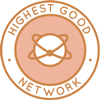 One Community is developing global-sustainability systems design through open source Highest Good Network® software that is a web-based application for collaboration, time tracking, and objective data collection. The purpose of the Highest Good Network is to provide software for internal operations and external cooperation. It is being designed for global use in support of the different countries and communities replicating the One Community sustainable village models and related components.
One Community is developing global-sustainability systems design through open source Highest Good Network® software that is a web-based application for collaboration, time tracking, and objective data collection. The purpose of the Highest Good Network is to provide software for internal operations and external cooperation. It is being designed for global use in support of the different countries and communities replicating the One Community sustainable village models and related components.
- Learn about our open source community collaboration and management software: The Highest Good Network
This week, the core team continued working on the Highest Good Network software by completing and confirming several pull request fixes. They worked on HGN PRs testing. Confirmed fixed PRs included Project page colors in Dark mode #2981, Resource Adding Form #3636, Event Attendance and No Show track #3081, Develop Visualizations for Event Popularity Analytics #3192, Listing and bidding platform: Create wish lists for users frontend #3325, Resource management dashboard #3611, Projects not showing up #3677, dropdown menu formatting in User Management page #3693, and the “failed to update task” issue when resolving tasks on the dashboard #3637. This effort contributes to One Community’s focus on global-sustainability systems design.
Items not fixed included finishing the “pop out” functionality for the timer PR 3112 #3559 and implementing pagination for the member list on the HGN Questionnaire Dashboard #3460. Additional work included reviewing assigned badges for “Tester One” and logging 5 hours for the week, with results recorded in the ongoing badge issues document. They also reported new bugs including fixing incorrect team codes after updates, restoring the missing “Form Creation” form on the ../jobformbuilder page, and correcting colors in Dark mode, and also assigned tasks to three volunteers. See the Highest Good Society and Highest Good Network pages for more on how this work strengthens global-sustainability systems design.
ALPHA SOFTWARE DEVELOPMENT TEAM
This week, the Alpha Software Team, working on the Highest Good Network software, was managed by Lin Khant Htel (Frontend Software Developer) and included Carlos Martinez (Software Developer) and Nikita Kolla (Full Stack Developer). This software serves as an internal management and communication platform designed to showcase global-sustainability systems design and supports social architecture, construction, production, and maintenance processes that contribute to creating sustainable and resilient ecosystems. Designed to be portable and scalable, the Highest Good Network software is well-suited for off-grid and sustainable living communities. This project reflects One Community’s open source commitment to advancing global-sustainability systems design as a path to long-term ecological solutions.
This week, Carlos worked on the HGN Form and the associated User Skills page, focusing on adding dark mode styling to the components. Additionally, he completed tasks assigned by Rishitha, which involved creating an announcement post about joining the team and integrating this information onto the team website. This work highlights One Community’s dedication to global-sustainability systems design. Furthermore, new work began on addressing fixes for bugs identified in the bug tracking documents. This work supports One Community’s goal of creating global-sustainability systems design. Lin managed the team before his week-off due to personal reasons. Nikita completed the task of ensuring that core team members’ additional hours are processed properly and uploaded the related code to a GitHub pull request. She then reviewed and analyzed the code related to the Blue Song assignment in preparation for making updates required for the Blue Square assignment tests. See the Highest Good Society and Highest Good Network pages for more on how this contributed to global-sustainability systems design. See the collage below for the team’s work.
BINARY BRIGADE SOFTWARE DEVELOPMENT TEAM
The Binary Brigade Team’s summary, presenting their work on the Highest Good Network software, was managed by Nikhil Routh (Software Engineer) and included Amalesh Arivanan (Software Engineer), Ramsundar Konety Govindarajan (Software Engineer), Harsha Rudhraraju (Software Engineer), Sourabh Bagde (Software Developer), Srushti Patel (Software Developer), Soham Sharma (Software Engineer), Manvi Kishore (Software Engineer), Taariq Mansurie (Full-Stack Developer), and Rohit Mamidi (Software Engineer). The Highest Good Network software is our tool for managing and objectively measuring progress, ensuring that all contributions are tracked, aligned with our mission, and global-sustainability systems design.
This week, Sourabh began work on creating the Slashdot auto-poster under the Announcements module by examining the codebase to determine placement and reviewing existing modules, such as Bitly and Blogger, for consistency in UI state management, form handling, and scheduling, with the task remaining in progress. Ram investigated two issues raised by Jae, confirming that the Resources section in Add Tasks worked as expected without changes and analyzing a problem with WBS categories defaulting to “Unspecified” after a page refresh; he traced the cause to AddTaskModal relying on allProjects, which may not be available on refresh, and updated the logic to use projectById, though additional fixes were still needed as the task view did not load properly. Nikhil worked on migrating legacy CSS files to CSS Modules, updating the LeaderBoard, Badge, TeamOrgLocations, and Teams components by converting .css files to .module.css, updating imports, and modifying className attributes. He also addressed issues in PRs 377, 3770, and 3222, updated PR 3760, tracked the CSS-to-Module migration task, reviewed PR 3864 and older pull requests, and oversaw teamwork by delegating tasks. Together, these efforts advance One Community’s pursuit of global-sustainability systems design.
Amalesh resolved the final linting errors in the UserProfile folder, fixed the Contributors Report display issue, addressed a bug with the dashboard header message on certain screens, submitted and merged a hotfix as PR 4060, and documented the work with screenshots and videos uploaded using the required conventions while tracking time with the HGN timer. This project strengthens One Community’s dedication to global-sustainability systems design. Taariq worked on filterColor functionality, archived projects, and weekly summaries, addressing pull request comments, running local tests, implementing archive and unarchive features in Project.jsx and Projects.jsx, resolving modal confirmation issues and console errors, fixing discrepancies in weekly summaries to ensure correct active and inactive user counts, and investigating backend integration test failures caused by Node version incompatibility. This work adds to One Community’s efforts in global-sustainability systems design. Harshavarma focused on application page/function cleanup by creating tasks for problematic pull requests, following up on in-progress work, and verifying completed items; reviewing PRs 4010 + 1693, 3964, 4048, 3889, 4034, 3937, and 1516; and identifying issues such as merge conflicts, dark mode inconsistencies, responsiveness problems, and missing data, while approving or requesting fixes as needed and updating CSS-to-module-CSS task tracking. This work contributes to One Community’s commitment to global-sustainability systems design.
Manvi attempted to test Pinterest auto-posting but faced permission and Node-related issues, and also assisted Jae with resolving a white page bug during project editing and an error in the WBS listing. This work reflects One Community’s dedication to global-sustainability systems design. Rohit analyzed badge validation workflows, focusing on time-based and event-driven dependencies, drafting test scenarios to reflect real-world behavior, and exploring opportunities for automation to reduce manual testing. Soham reviewed 10 pull requests, verifying functionality across charts, profile updates, FAQ alignment, dropdowns, dark mode behavior, redirection handling, and lint/test case compliance, reporting issues where necessary. Srushti worked on the teacher portal Figma frames and components, improving organization and usability, while also resolving two urgent bugs to maintain project stability. See the Highest Good Society and Highest Good Network pages for more about how this relates to global-sustainability systems design. The collage below shows images of their work.
BLUE STEEL SOFTWARE DEVELOPMENT TEAM
This week, the Blue Steel Software Team, working on the Highest Good Network software, was managed by Divanshu Bakshi (Product Manager) and includes Linh Huynh (Software Engineer), Felix Huang (Software Engineer), Humemah Khalid (Software Engineer/Backend Developer), and Sheetal Mangate (Software Engineer). Linh worked on configuring the local development environment to connect the frontend with the backend service running on port 4500, which required modifying the Vite configuration to set up a proxy for API calls, adjusting environment variables to prevent defaulting to the staging API, and validating backend startup logs to confirm database connectivity and port usage within the global-sustainability systems design framework. He tested communication between the React frontend running on port 5173 and the backend server, verified the use of .env.local for local overrides, ensured compatibility with Create React App style environment variables, and reviewed proxy and CORS configurations. He also documented how to isolate local API calls during development and completed updates to the FAQ Tool unanswered question logging issue by adding support for both raw and Bearer tokens, refining duplicate detection, and modifying logging behavior when no owner emails are available. This work supports One Community’s mission and focus on global-sustainability systems design.
Felix resolved the issue of WBS categories not assigning correctly on refreshed WBS pages and submitted a pull request, then began investigating overlapping text on the Dashboard after refresh; while reproducing the bug, he confirmed the issue was absent in the development branch but persisted in production and reached out to Jae for guidance. Humemah worked on the bell notification feature for task deadlines by implementing alerts at 50%, 75%, and 90% of a task’s deadline, extending existing logic originally built under reference #2631 to align with prior functionality. Sheetal resolved merge conflicts in the Announcement module, integrated code into the updated design structure, continued connecting frontend flow with backend APIs under the global-sustainability systems design initiative, and added functionality to detect existing Reddit tokens when loading the editor, with logic to display a connection button if tokens were expired or invalid, though testing of Reddit API integration was limited by IP rate restrictions. These combined efforts advance One Community’s commitment to global-sustainability systems design. Below are some images showcasing this work.
CODE CRAFTERS SOFTWARE DEVELOPMENT TEAM
The Code Crafters Team, covering their work on the Highest Good Network software, was managed by Sai Shekhar Reddy Moola (Software Engineer) and includes Ajay Naidu (Software Engineer), Ashrita Cherlapally (Software Engineer), Benitha Sri Panchagiri (Software Engineer), Chaitanya Swaroop Kumar Allu (Software Engineer), Hemanth Chimakurthi (Software Engineer), Juhitha Reddy Penumalli (Software Engineer), Rohith Mallipudi (Software Engineer), Sphurthy Satish (Software Engineer) and Vivek Chandra (Software Engineer). The Highest Good Network software is how we’ll manage and objectively measure our process for establishing abundant community systems through our social architecture, construction, production, and maintenance processes, and support widespread and lasting eco-lifestyle access. This effort exemplifies One Community’s open source commitment to Global-Sustainability Systems Design as a path to a more regenerative and thriving world.
This week, Ajay built the feedback UI landing page component that serves as the entry point for opening the feedback modal, created and applied page-specific CSS, organized styles into dedicated files, imported those styles into both the page module and global stylesheet to maintain consistency, wired the landing page interaction to trigger the modal, aligned the component structure with the project’s module pattern, and reduced style duplication by centralizing shared rules. This work aligns with One Community’s goals for global-sustainability systems design. Ashrita worked across the frontend and backend of the Highest Good Network codebase, resolving a blocked stash, preparing ESLint fixes for unused imports and variables, updating parseInt calls with a radix, resolving duplicate keys and shadowed variables, and documenting options to bypass hooks while outlining follow-up steps to restage and commit clean changes. This initiative supports One Community’s dedication to global-sustainability systems design. Benitha reduced compile and test errors by fixing missing exports and incorrect imports in multiple action files, added required functions to align with test cases, updated reducers and actions for consistency, and lowered the ESLint error count from 106 to 78. Chaitanya focused on the Access Management component and Google Group integration, migrated Dropbox data from emails to folder IDs using scripts, analyzed inconsistencies and missing records, reviewed and confirmed a fix with teammates, and worked on adding Google Group invite access by testing API documentation and exploring efficient implementations. This work is part of One Community’s focus on global-sustainability systems design. Hemanth validated multiple pull requests, confirming dashboard messages (PR #4025), new fields and modal behavior in the ApplicationForm (PR #4026), project membership features (PR #4027), filters on the listing and bidding dashboard (PR #4028), analytics graphs and date range functionality (PR #4033), scoped CSS styles (PR #4034), dark and light themes on HGNForm pages (PR #4038), error messaging for non-existent profiles (PR #4042), participation report loading (PR #4065), and also investigated bug #1720. This effort reflects One Community’s commitment to global-sustainability systems design.
Juhitha contributed to the Phase 2 Summary Dashboard line chart by adding a backend POST API for injury data, testing with mock data, integrating the API on the frontend, verifying filters and graph behavior, completing full implementation testing, and raising pull requests for both frontend and backend while also beginning work on the Project Status Donut Chart by resolving merge conflicts and checking stability. This work highlights One Community’s dedication to global-sustainability systems design. Rohith reviewed multiple pull requests, confirming CSS module updates in PRs #4001 and #3937, verifying one merge, and testing PR #4034, where a loading issue blocked further validation, after which he coordinated with Varsha Karanam on the related FAQ section task currently under review. Sai Moola progressed on the Summary Dashboard by creating a horizontal bar graph titled “Utilization Rate and Downtime of Tools/Equipment.” This involved generating mock data with POST endpoints, modifying the schema to handle date ranges, testing the GET endpoint for tool downtimes, and verifying date query parameters. This contribution advances One Community’s goals for global-sustainability systems design. Request optimization is pending. Sphurthy resolved a countdown timer bug by correcting toast content formatting, adding a state check to ensure notifications triggered only once, restoring proper functionality, and also updated Phase 4 deliverables by reviewing, modifying, and aligning them with project requirements. Vivek reviewed Harshitha’s software document, examined code contributions to understand the project state, joined a call on HGNRest Phase 4 to clarify responsibilities and deliverables, evaluated planned tasks, and studied the onboarding document to support his ongoing work. These contributions strengthen One Community’s open source mission and commitment to global-sustainability systems design. See below for pictures of the team’s work.
DEV DYNASTY SOFTWARE DEVELOPMENT TEAM
The Dev Dynasty Team’s summary, covering their work on the Highest Good Network software, was managed by Zhifan Jia (Software Engineer) and includes Adithya Cherukuri (Software Engineer), Deekshith Kumar Singirikonda (Developer), Dharmik Patel (Software Engineer), Manvitha Yeeli (Software Engineer), Mohan Satya Ram Sara (Software Engineer), Nahiyan Ahmed (Full-Stack Software Developer), Neeraj Kondaveeti (Software Engineer), Prasanth Bhimana (Software Engineer), Saicharan Reddy Kotha (Software Engineer), Shraddha Shahari (Software Engineer), Vamsi Krishna Rolla (Software Engineer), and Vamsidhar Panithi (Software Engineer), Varsha Karanam (Software Engineer). The Highest Good Network software is how we’ll manage and objectively measure our process for global-sustainability systems design through our social architecture, construction, production, and maintenance processes. This progress supports One Community in developing global-sustainability systems design.
This week, Nahiyan reviewed PR4038 by examining changes to the codebase, verifying alignment with project standards, testing functionality for expected results, and assessing impacts on maintainability, performance, and readability while providing feedback on potential issues. This effort helps One Community’s pursuit of global-sustainability systems design. Shraddha worked on fixing lint issues in PeopleTasksPieChart.test.jsx, analyzing errors, modifying related files, and implementing a fix that is still being tested, while also addressing PRs 2210, 2266, and 3492 by resolving conflicts, investigating build failures, and troubleshooting issues related to Node 20, eslint, vite:esbuild, and jest:esbuild. Vamsi enhanced feedback management and organizer controls by implementing filters and sorting options for hosts, adding a toggle in event settings for review requests, creating notices for participants when reviews are disabled, and including a “Contact Admin” link, followed by testing and refinements to ensure host-only feedback, filtering, and toggling functioned correctly. This project strengthens One Community’s dedication to global-sustainability systems design. Manvitha resolved review comments related to the logo, fixed merge conflicts in PRs 3870, 4001, 3647, and 1454, implemented event rescheduling functionality including sending participant emails, and began integrating polling options through email while troubleshooting an unauthorized request error. This work adds to One Community’s efforts in global-sustainability systems design.
Saicharan completed the Phase-2 Project Status Donut Chart by creating and pushing frontend and backend PRs with detailed descriptions, testing instructions, screenshots, and explanations of the React component with Chart.js, CSS Modules, backend model, service, and controller logic, connecting the frontend to the API, validating functionality with filters, and refining PRs after feedback. This initiative aligns with One Community’s commitment to global-sustainability systems design. Deekshith strengthened wishlist functionality for the listing and bidding platform by creating secure backend APIs with ownership and validation rules, implementing createWishlist, addListingToWishlist, and removeListingFromWishlist functions that validate user authentication, deduplicate listings, and ensure proper ownership and existence checks. Adithya contributed to Phase 3 tasks and analytics features for HGN Software Development by resolving dependency conflicts, updating yarn.lock, merging from development, verifying component placement for the Social and Recreational Management page and Event Popularity Analytics landing page, completing frontend and backend development for the Popularity by Timeline Chart, and submitting a pull request awaiting review. Neeraj reviewed potential new tasks, examined previously completed work for bugs or misalignments, and submitted a self-summary with the requested information. Mohan implemented timelog usage tracking by populating databases with mock events, optimizing queries, enabling live updates via WebSocket with fallbacks, linking event creation to backend confirmation, handling idle and network interruptions, and improving UI confirmations for accurate logging. Prasanth drove Phase 2 document finalization by reviewing over 50 pages, testing PRs locally, identifying issues, creating new action items—especially around modular CSS—coordinating with developers via Slack, and proposing workflow and UI/UX improvements to strengthen Phase 2 deliverables. Vamsidhar resolved merge conflicts and tested PR3040, implementing a feedback modal with a rating system, comment field, duplicate prevention, Node.js version updates, Jest-to-Vitest migration, accessibility fixes, and CI workflow updates, achieving 1945 of 1951 passing tests and preparing the PR for deployment. Varsha created and submitted a questionnaire form within the collaboration module, integrated video links, improved state management and validation, and transitioned global CSS to modular CSS for various components, including the event no-show chart, resolving related styling errors and ensuring modular, isolated design consistency. Zhifan advanced the Node 14 to Node 20 upgrade by resolving lint violations, merging the latest development branch, validating tests, confirming functionality across 80 files, and worked on backend analytics by implementing strict role checks for endpoints and adding warnings for overlapping dates in the summary API. See the Highest Good Society and Highest Good Network pages for more on how this relates to developing global-sustainability systems design. Explore some of the team’s work in the collage below.
EXPRESSERS SOFTWARE DEVELOPMENT TEAM
The Expressers Team’s summary, which covers their work on the Highest Good Network, was managed by Rahul Trivedi (Software Engineer) and includes Casstiel Pi (Software Engineer), Meenashi Jeyanthinatha (Full-Stack Developer), and Tanmay Arora (Software Engineer). This contribution supports One Community’s goal of advancing global-sustainability systems design.
This week, Casstiel worked on the Plurk auto-poster feature, troubleshooting environment setup issues with Node Version Manager and package installations, then updating the user interface to align with the unified tab structure for auto-posters across social media platforms. This work is part of One Community’s focus on global-sustainability systems design. Meenashi updated the Application/Job Posting Page and design document, added images for multiple views including Category List, Position List, Show Summaries, Dark Mode, and Mobile View, and contributed to PRs #1701, #4014, and #1462 by resolving merge conflicts, enhancing test coverage, and addressing review comments. She also investigated access restrictions for the Skills form related to PR #4009.
Tanmay focused on advancing the Mastodon auto-poster feature by reviving backend code from an earlier pull request, configuring environment variables, and creating a POST endpoint for publishing to Mastodon. On the frontend, he added a dedicated Mastodon tab within the Announcements module, extended the SocialMediaComposer with new props and controls, and confirmed successful posting from the dashboard to Mastodon. Together these updates improved the stability, functionality, and integration of the Highest Good Network. This work contributes to One Community’s mission of advancing global-sustainability systems design. Rahul refined the codebase by creating modular classes to handle duplicate logic and improve maintainability. He added functional components for light and dark mode transitions, optimized related files, and polished CSS to ensure smoother theme switching. He augmented class names, improved event listeners, and removed unused styles that were causing overrides, resulting in cleaner styling and faster load times. In addition, Rahul fulfilled team management responsibilities by reviewing tasks, summaries, and videos from team members. See the Highest Good Society and Highest Good Network pages for more on how this contributed to advancing global-sustainability systems design. See the collage below for the team’s work.
LUCKY STAR SOFTWARE DEVELOPMENT TEAM
The Lucky Star Team’s summary, which covers their work on the Highest Good Network, was managed by Keerthana Chitturi (System Administrator) and Barnaboss Puli (Software Engineer). The team includes contributions from Chieh “Jerry” Jui Lee (Software Engineer), Dipti Yadav (Software Engineer), Durga Venkata Praveen Boppana (Software Engineer), Ganesh Karnati (Software Engineer), Kedarnath Ravi Shankar Gubbi (Software Engineer), Shashank Madan (Software Engineer), Shravya Kudlu (Software Development Engineer), Sohail Uddin Syed (Software Engineer), Veda Bellam (Software Engineer), and Venkataramanan Venkateswaran (Software Engineer). Their work continued to support our goal of global-sustainability systems design through collaborative and cross-functional software development.
This week, Barnaboss extended validation and refined logic for the volunteer hours distribution pie chart, improved performance through pipeline adjustments and safeguards, optimized aggregation queries for utilization and downtime metrics, aligned backend responses with frontend schemas, and fixed state management issues in the Project Details section. This contribution supports One Community’s initiative of global-sustainability systems design. Chieh tested and investigated the Account Edit page, identifying that legacy accounts lacked an id field and confirming that both new and old accounts now support full edit functionality. This update ensures data consistency and supports the development of global-sustainability systems design. Dipti debugged and fixed a reported error with the unsubscribe and subscribe pages by restoring missing lines in the routes.jsx file, then began reviewing data flow and code patterns to prepare for graph creation and functionality integration. This task adds to the progress toward global-sustainability systems design. Durga resolved header alignment issues across screen sizes, addressed additional problems in a previous pull request, progressed on renaming files to module.css, and began initial work on the system date issue. This effort advances the work on global-sustainability systems design. Ganesh worked on the backend for the Tools Most in Need of Replacement task, setting up and refining API routes, updating controller functions, validating queries, and verifying results through integration testing. This backend development supports global-sustainability systems design.
Kedarnath progressed on Job Posting Page Analytics by implementing a donut chart to visualize applicants by experience levels, focusing on chart integration and responsive UI behavior. This work improves reporting tools in support of global-sustainability systems design. Shashank implemented functionality for handling the timer and time logging process when the week closes, ensuring timers pause, auto logging occurs with temporary descriptions, backend payloads update correctly, and frontend modals handle these conditions. His contributions strengthen system reliability for global-sustainability systems design. Shravya completed the feature request to add CC email input with the Enter key under PR #4002, converted CSS to module.css with dark mode support under PR 4053, restored routing and reorganized files under PR #4049, and refactored frontend code for consistency with backend changes under PR 4053. This effort continues to improve user functionality for global-sustainability systems design. Sohail collaborated with Anthony on the HGNRest email automation project, reviewed documentation, began local setup, and prepared for cronjob-based automation to handle different user conditions. This automation work supports global-sustainability systems design. Veda worked on the Country of Application Map Chart by reviewing requirements, documenting backend schema and caching needs, aligning frontend code for hover data and filters, and setting up the technical environment by installing dependencies and resolving Apple Silicon build issues. These improvements align with One Community’s focus on global-sustainability systems design. Venkataramanan raised seven pull requests frontend PRs #4039, #4041, #4043, #4044, and #4051, along with backend PRs #1714 and #1719 addressing UI issues, fixing layouts, refining component interactions, and ensuring backend consistency. These updates enhance platform stability and contribute to global-sustainability systems design. See the Highest Good Society and Highest Good Network pages to learn more about how this work supports global-sustainability systems design. Below is a collage highlighting the team’s contributions
MOONFALL SOFTWARE DEVELOPMENT TEAM
This week, Team Moonfall’s summary, which covers their work on the Highest Good Network, was managed by Shashank Halanur Veeresh Kumar (Software Engineer) and includes Aayush Jayant Shetty (Software Engineer), Alisha Walunj (Software Engineer), Bangaru Babu Kota (Software Engineer), Bhavpreet Singh (Software Engineer),Gurusai Chittoji (Software Engineer), Mani Shashank Marneni (Software Engineer), Ramakrishna Aruva (Software Engineer), Sai Krishna (Software Engineer), Swetha Rachakonda (Software Engineer), Uha Kruthi (Software Engineer), Venkata Nikitha Anakla (Software Engineer), and Zhicheng Tong (Software Engineer). This contribution supports One Community’s goal of advancing global-sustainability systems design.
This week, Shashank created a new pull request for the weekly summary dashboard, fixed issues with the chart, moved files, and added a module.css file for styling. Aayush worked on the Phase 2 Summary Dashboard by creating line and bar charts, fixing bugs, and adding a dark mode toggle. Alisha resolved merge conflicts, built backend and frontend components for the bid page overview, added endpoints for listings and bids with notifications, and fixed issues with dark mode, alignment, image zooming, and username display. Bangaru addressed HGN Software Development tasks by resolving dashboard queries, improving documentation clarity, finalizing design elements, and reviewing requirements. Bhavpreet connected the LB dashboard with the word cloud and demand-over-time charts, merged them, and resolved conflicts in older pull requests. These efforts reflect One Community’s commitment to global-sustainability systems design. Gurusai reviewed pull requests within the Application 135 initiative, provided feedback, collaborated with the team lead on improvements, and finalized the weekly summary report. Mani fixed a bug in the Phase 2 Summary Dashboard related to tool returns by building a controller and router, integrating with MongoDB, validating records, and resolving errors.
Ramakrishna began fixing an issue where zero time was displayed on the reports page by creating a new branch, correcting an API call and MongoDB team ID handling, and improving data retrieval. Sai implemented modal handling functions in WeeklySummaries.jsx with an edit button, modal rendering, and updates for the initialActiveTab prop. Swetha implemented the job application form page with React components, CSS styling, validation, file handling, and dark mode preparation. This work highlights One Community’s dedication to global-sustainability systems design. Uha progressed on the SMS notification feature by working on backend services, user preferences, secure storage, and frontend settings. Nikitha developed the Replicate Task feature by adding a task replication button, creating Redux action types, connecting them to the reducer, implementing an API call, and adding a tooltip. Zhicheng familiarized himself with the codebase and logging system, set up a branch named fix-demo-logs, worked on adjustments to align with standards, reviewed task-tracking processes, and applied the team’s practices for writing and testing code. Together, these contributions support One Community’s pursuit of global-sustainability systems design. For more context on how this contributed to advancing global-sustainability systems design, see the Highest Good Society and Highest Good Network. The collage below features select contributions from our team members this week.
REACTONAUTS SOFTWARE DEVELOPMENT TEAM
The Reactonauts Team’s summary, covering their work on the Highest Good Network, was managed by Sai Suraj Matta Veera Venkata (Business Data Analyst) and Akshay Jayaram (Software Engineer). The team includes Aseem Deshmukh (Software Developer), Diya Wadhwani (Software Developer), Ghazi Rahman Shaik (Software Engineer Intern), Guna Pranith Reddy Cheelam (Software Developer), Jaydeep Mulani (Software Developer), Kristin Dingchuan Hu (Software Engineer), Namitha Vijaykumar Pawar (Software Engineer), Peterson Rodrigues dos Santos (Full Stack Developer), Raahul Sallagunta (Software Engineer), Siva Putti (Software Engineer), Sreeja Nandyala (Software Engineer), Sri Satya Venkatasai Siri Sudheeksha Vavila (Software Engineer), Suparshwa Patil (Software Engineer), and Ujjwal Baranwal (Full-stack Software Developer). The Highest Good Network software helps manage and objectively measure progress by focusing on developing global-sustainability systems design. It supports social architecture, construction, production, and maintenance processes to build sustainable and thriving ecosystems.
This week Akshay continued working on the issue of project members not being listed, traced the problem to changes introduced in PR1714 that modified the getprojectMembership function, consulted with Jae about whether to adjust the existing endpoint or create a new one, and coordinated Reactonauts activities including pull request tracking, Git error assistance, weekly team review, and discussions about team call leadership. This work adds to One Community’s efforts in global-sustainability systems design. Aseem analyzed conflicts between Marcus’s base announcement tab wireframe in PR3866 and Namitha’s PR4029 addressing lint issues that replaced Marcus’s implementation, noted that progress depended on code merging, created new developer accounts for Instagram and Threads, began setting up an application for Threads, and reviewed a reference link. Diya configured Gmail OAuth credentials for reset-password email flow, verified functionality, and opened PR1716, fixed a failing test, resolved conflicts from Backend release 2.57 in PR1715, and opened PR1717. This project contributes to One Community’s approach to developing global-sustainability systems design. She also addressed an urgent bug where resources were not visible when adding tasks by fixing a role mismatch in the database, corrected WBS visibility from user profiles by aligning parameter naming differences, and raised PR4056 for the fix. Ghazi optimized task management components under PR3586 by using a preloaded dataset, resolving data mapping inconsistencies, unblocking merges by fixing a critical test failure, resolving password-related conflicts, and adding debugging logs. This work contributes to One Community’s commitment to global-sustainability systems design.
Guna Pranith finalized listings home page fixes under PR3999 by resolving image request errors and correcting tab headings, with the focus shifting toward review, approval, and preparing for further listings page tasks. This work reflects One Community’s dedication to global-sustainability systems design. Jaydeep reviewed and tested multiple frontend and backend PRs including PR4042 for user profile error messaging, PR4050 for profile save functionality, PR4049 and PR4048 for materials and roles graphs, PR4053, PR4033, and PR4031 for graph rendering and styling, PR3629 for form validation, PR3625 for Teams table alignment, PR3613 for filters and buttons, and PR3029 for community calendar conflicts, while also troubleshooting PR4040 compatibility issues and reviewing internal task documents. This work supports One Community’s mission of global-sustainability systems design. Kristin addressed changes in PR3851 and PR4036, resolved lint errors in TeamMemberTasks including TeamMemberPopup.jsx, removed files from eslint ignore, fixed merge conflicts, updated the Promotion Table UI for better dark mode visibility, and began unit tests for the backend reports controller. This project contributes to One Community’s approach to developing global-sustainability systems design. Namitha fixed a missing route entry in routes.jsx so EventParticipation rendered correctly at /communityportal/reports/participation, tested it locally, checked other routes for conflicts, and submitted PR4065. Peterson updated the User Profile page in PR4042 so that invalid user IDs show a clear “no matching user” message with a redirect option instead of hanging on a loading indicator. This effort contributes to One Community’s focus on global-sustainability systems design. Raahul spent 20 hours on HGN Phase 4 Deliverables 4 and 5 by reviewing documentation for badge integration, reporting and analytics features, ensuring requirements were well structured with roles and deadlines, suggesting sample data flows, and starting work on an urgent backend bug related to project assignment persistence tied to PR1719. This work aligns with One Community’s goals for global-sustainability systems design.
Siva worked on PR2816 to restore missing search functionality on the Team Member Reports page and on PR2992 to fix pie chart color discrepancies, addressing merge conflicts and ensuring consistent chart display. This work is part of One Community’s focus on global-sustainability systems design. Sreeja tracked progress on backend title search merges, confirmed completion of PR3892 fixes, monitored analytics page frontend and backend updates, reviewed referral link PR4012, merged the Figma analytics task, followed up on FAQ tool progress, confirmed closure of the job posting analytics bar graph fix PR3913, and reviewed PRs 3989, 1685, and 3870. This effort reflects One Community’s commitment to global-sustainability systems design. Sudheeksha dedicated 20 hours across four days to resolving resource access issues in PR3924, fixed lint issues in TeamMembersPopup, implemented and tested urgent hotfixes to restore resource add/view functionality, and ensured stable access for users. Suparshwa researched tools for document storage, evaluated free options for reliability and ease of use, and identified candidates that could meet project needs. This work highlights One Community’s dedication to global-sustainability systems design. Ujjwal contributed to two urgent hotfixes by resolving a member display issue caused by a permission mismatch, fixed a dashboard styling bug by refactoring FollowUpEmailTemplate.css to module.css under PR4074, addressed merge conflicts, and worked on the “Make Delete function remove people” task by investigating the underlying bug. See the Highest Good Network and Highest Good Society pages to learn more about how this work supports developing global-sustainability systems design. See below for the work done on developing global-sustainability systems design.
SKYE SOFTWARE DEVELOPMENT TEAM
Skye Team’s summary, covering their work on the Highest Good Network, was managed by Georgina George (Business Intelligence Data Analyst and Team Administrator) and Anthony Weathers (Software Engineer). The team includes Julia Ha (Software Engineer), Marcus Yi (Software Engineer), and Snehal Dilip Patare (Software Engineer). The Highest Good Network software helps manage and objectively measure progress by focusing on creating an ecological living paradigm. It supports social architecture, construction, production, and maintenance processes to build sustainable and thriving ecosystems. This solution is portable, scalable, and ideal for off-grid or sustainable living communities. This effort exemplifies One Community’s open source commitment to global-sustainability systems design as a path to global sustainability. This contribution advances One Community’s goals for global-sustainability systems design.
This week, Anthony addressed a reviewer’s comment on PR#3978 regarding a reported 401 error. During his investigation, he reproduced related log errors but did not encounter the 401 himself. This work represents One Community’s focus on global-sustainability systems design. After reviewing the code, he determined the error message originated from notification files rather than his own changes, and he wrote a response requesting additional details. He then continued testing the email features from the reverted PR#1104 and PR#1334, fixing one of the email functions to correctly retrieve a required user value from the database. He recorded videos outlining his findings, submitted them for feedback, and began testing automation of the emails through a cronjob using preset values. This effort helps One Community’s pursuit of global-sustainability systems design. This work prepared the feature for further testing next week to ensure it met the desired functionality. Finally, he began work on the Tracking Modal task for moving descriptions in the Dashboard warning tracker, enabling reordering of the tracker list. Although saving functionality had not yet been added, he created a video update on his progress and awaited feedback on how best to proceed with meeting the task requirements. This work supports One Community’s goal of creating global-sustainability systems design.
Julia continued working on creating the special filter for team codes and individuals by adding a CRUD backend that allowed users to create, read, update, and delete filters in the database. This work adds to One Community’s efforts in global-sustainability systems design. She integrated the API with the frontend so that interactions from the user interface were stored in the database and addressed the team code change scenario to ensure filters were updated when codes changed. She also fixed several bugs in the existing code, including updating tableData when a team code changed, and optimized the filterWeeklySummaries function to improve performance. This work contributes to One Community’s commitment to global-sustainability systems design. Marcus worked on diagnosing a failure in the scheduled post feature for X, reviewing request and response handling while API rate limits limited full end-to-end debugging. He supported Jae by investigating and addressing a main branch error, including checks on build and dependency integrity, and he organized his development environment by cleaning VS Code extensions, settings, and workspace files to streamline future work. This work reflects One Community’s dedication to global-sustainability systems design. Snehal worked on cleaning the Facebook auto poster code in index.js, updated it to handle scheduling posts in the PST timezone, and modified the system to display hints for both Twitter and Facebook when the corresponding social media tabs were selected. She also completed backend tasks PR3466 and PR1359 and was waiting for approvals. See the Highest Good Society and Highest Good Network pages for more on how this contributed to global-sustainability systems design. See the collage below for the team’s work.
SOFTWARE PR REVIEW TEAM A-F
This week, the PR Review Team’s summary for members with names starting A–F, managed by Neeharika Kamireddy (Data Analyst), highlights their contributions to the Highest Good Network software. This platform forms the foundation for measuring our results in developing global-sustainability systems design. Active team members included Abdelmounaim Lallouache (Software Developer), Abhishek Srikanth (Software Engineer), Aditya Gambhir (Software Engineer), Carl Bebli (Software Developer), Chris Bellara (Software Engineer), Deep Shah (Software Engineer), and Dunstan Dsouza (Software Engineer). They supported the project by thoroughly reviewing all pull requests shared this week. Learn more about how the Highest Good Network tracks progress toward developing global-sustainability systems design in the Highest Good Network open source hub. The collage below showcases this team’s work.
SOFTWARE PR REVIEW TEAM G-N
This week, the PR Review Team’s summary for team members with names starting from G–N, covering their work on the Highest Good Network software, was managed by Govind Sajithkumar (Software Project Manager). The Highest Good Network software is a foundation for measuring our results in developing global-sustainability systems design. This week’s active members of this team were: Kurtis Ivey (Full Stack Developer), Munish Patel (Software Engineer), Nahiyan Ahmed (Full Stack Software Developer), and Nathan Hoffman (Software Engineer). They reviewed all the Highest Good Network PRs (Pull Requests) shared in this week’s update. Learn more about how the Highest Good Network measures developing global-sustainability systems design by exploring the Highest Good Network open-source hub. The collage below shows a compilation of the work from this team.
SOFTWARE PR REVIEW TEAM O-Z
This week, the PR Review Team’s summary for team members with names starting from O–Z, covering their work on the Highest Good Network software, was managed by Jaiwanth Reddy Adavalli (Software Project Manager). The Highest Good Network software is a foundation for measuring our results in developing global-sustainability systems design. This week’s active members of this team were: Pujitha Kakani (Software Engineer), Sudheesh Thuralkalmakki (Full-Stack Developer), Sundar Machani (Software Engineer), Xinyi Zhou (Developer), Yiyun Tan (Software Engineer), and Zoha Khan (Software Engineer). They reviewed all the Highest Good Network PRs (Pull Requests) shared in this week’s update. Learn more about how the Highest Good Network measures developing global-sustainability systems design by exploring the Highest Good Network open-source hub. The collage below shows a compilation of the work from this team.
AND WE PRODUCED THIS WEEKLY UPDATES BLOG – CLICK HERE TO SUBSCRIBE
FOLLOW ONE COMMUNITY’S PROGRESS (click icons for our pages)
INVESTOR PAGES
GET INVOLVED
DONATE | WAYS ANYONE CAN HELP | MEMBERSHIP
CLICK HERE FOR ALL PAST UPDATES
 One Community
One Community